Talk:India/Archive 44
| This is an archive of past discussions about India. Do not edit the contents of this page. If you wish to start a new discussion or revive an old one, please do so on the current talk page. |
| Archive 40 | ← | Archive 42 | Archive 43 | Archive 44 | Archive 45 | Archive 46 | → | Archive 50 |
New Images - Proposals
Please let me know if there are any objections to these new rotating images. Kindly comment below. (Highpeaks35 (talk) 00:31, 2 January 2019 (UTC))
New Images - Clothing
- Rotate

- Images
-
The Didarganj Yakshi depicting the dhoti wrap.
-
A Hindu Indian wedding, with the groom wearing a sherwani and pagri turban, while the bride in a sari.
-
Indian women with dupatta.
Support or Oppose
- Support: The rotating image provides value to section. (Highpeaks35 (talk) 02:34, 2 January 2019 (UTC))
- Oppose:
Unmitigated garbage.All stitched clothes were introduced to India by the Muslims; all garments of gods and goddesses of the Hindu pantheons in Hindu temples in North India are made by Muslim tailors. Indeed the profession of a tailor in north India is usually associated with Muslims.What is all this Hindu garbage.The Hindus wore only draped clothes before the Muslim conquest of India. This is documented in several books on the history of clothing in India. Fowler&fowler«Talk» 22:02, 2 January 2019 (UTC)
- @Highpeaks35: I apologize for the intemperate and ambiguous language. Nothing personal was meant. I have scratched that bit.Fowler&fowler«Talk» 05:52, 3 January 2019 (UTC)
- Fowler&fowler (talk · contribs) Your bigitory with the above statement is not acceptable. No one made it Hindu vs. Muslim. It is about Indian clothing, regardless they are from Northeast, North, South and historical image of drapes. Again, you need to apologize for your language like "Hindu garbage".
- @Anarchyte, Oshwah, and RegentsPark: please see the above statement by User:Fowler&fowler, such racist and religiously sectarian and communal language should not be permitted on wiki. "Hindu garbage" - are you kidding me? (Highpeaks35 (talk) 01:43, 3 January 2019 (UTC))
- The bigotry is not mine; it is yours. You are the one who is relentlessly introducing "Hindu" when Hindu is irrelevant, advertising the garments in the context of Hindu, when the garments were introduced by Muslims into India. Sherwani, achkan, paijama, are all Muslim garments. Please don't try project your own biases on others. Fowler&fowler«Talk» 02:23, 3 January 2019 (UTC)
- PS And what about the elitist, Bollywood, culture masquerading as Indian culture. Really? Most Indian women wear string blouses with their saris? What percentage? 0.01% That is true racism, showcasing light-skinned Bollywood actresses wearing apparel out of the reach of 99% of India. Fowler&fowler«Talk» 02:27, 3 January 2019 (UTC)
- Nothing in those cloths were religion based. Only the wedding were mentioned. You bought the crude language, by using "Hindu garbage". Those cloths, as described, are worn by majority of people, cherry-picking one sting blouses pic is non-issue and we could have removed that. Now you are bringing skin color? Wow!!! I am lost for words. Only 3 pics are Bollywood, two images are from the northeast, and two wedding photos and 2 artistic. Your racism and bigotry is unacceptable. I will do everything to report you. Calling me and my edits "Hindu garbage" will not get you anywhere. (Highpeaks35 (talk) 02:34, 3 January 2019 (UTC))
- The bigotry is not mine; it is yours. You are the one who is relentlessly introducing "Hindu" when Hindu is irrelevant, advertising the garments in the context of Hindu, when the garments were introduced by Muslims into India. Sherwani, achkan, paijama, are all Muslim garments. Please don't try project your own biases on others. Fowler&fowler«Talk» 02:23, 3 January 2019 (UTC)
- Oppose : because it does not adequately represent the Indian ethnic dressing. South Indian dresses are missing. --DBigXrayᗙ 13:54, 3 January 2019 (UTC)
- DBigXray, what specific South Indian dress are you refering to? Saris and Dhotis are the main south Indian dresses, and both are listed. (Highpeaks35 (talk) 01:36, 4 January 2019 (UTC))
- Please google South Indian dress also It is mostly Sari pics, gents wear should also be added.--DBigXrayᗙ 23:29, 4 January 2019 (UTC)
- DBigXray, what specific South Indian dress are you refering to? Saris and Dhotis are the main south Indian dresses, and both are listed. (Highpeaks35 (talk) 01:36, 4 January 2019 (UTC))
- Oppose This just isn't everyday wear, any person wearing this stuff everyday will be laughed at. Also, the midriff and navel stuff is extremely one-sided and doesn't take into consideration a major portion of the Indian population. Even if we consider that this is ceremonious wear it is still way out of touch with the realities. Regards. — fr ❄ 05:39, 4 January 2019 (UTC)
- I concur with User:FR30799386--DBigXrayᗙ 23:29, 4 January 2019 (UTC)
- Oppose - at least for the actresses and the Arvind Singh Mewar wedding. Google gives quite another impression for group Indian women, let alone group Indian men. [2] surely must be helpfull here.
- Joshua Jonathan -Let's talk! 05:48, 5 January 2019 (UTC)
- Love your images Joshua Jonathan. However, King Zebu and Highpeaks35 are looking to portray the Shining India and consider such images "poverty porn," to use KZ's expression. Fowler&fowler«Talk» 06:41, 5 January 2019 (UTC)
- Joshua Jonathan, thanks for your input. I have removed them and added one of your image. Let me know if you vote changes. Thanks for being easy to work with, unlike Fowler&fowler. Just his above statement was simply uncalled for, rude and bigoted. (Highpeaks35 (talk) 04:40, 6 January 2019 (UTC))
- @DBigXray and FR30799386: Joshua Jonathan made very good recommendations, let us know if the above now is acceptable. Or if there are more images you recommend. Please put it below. (Highpeaks35 (talk) 04:42, 6 January 2019 (UTC))
- Comment I have now loaded all the images currently in the article in the subpage User:Fowler&fowler/Images in FA India. There are a total of 71 images in the article, including ten Featured Pictures. Many pictures are part of a rotating stack, so you won't see them all the time. The rotation was originally cyclic, incrementing by one every day. However a few years ago someone, without any discussion, changed it to random rotation, which means that the images are chosen randomly in the stack. Therefore, you might see the same image on two consecutive days, or you might not see it for many days, more days than there are images. I have pinged the editor who did this, and, in the absence of a reply, will be changing it back to cyclic rotation. Anyway, I have the sense that many editors are not aware of the full range of images that are already in the article. Please take a look at those images, and make your suggestions in the context of what is there. Please note that clothes, some beautiful ones, appear in many of these pictures. If you want some images removed, please make those suggestions too, suggesting replacements. I will soon be creating another subpage consisting of Wikipedia India-related featured pictures that are not already in the article. Once that page will be ready, there will be more choices available. Best regards, Fowler&fowler«Talk» 22:31, 6 January 2019 (UTC)
@Highpeaks35: no need to repeat statements like "bigoted." And don't be mistaken: I can be a pain in the ass when I sense unjustified behavior. Joshua Jonathan -Let's talk! 05:12, 6 January 2019 (UTC)
- @Joshua Jonathan: do you have more recommendations? I want to win your vote. (Highpeaks35 (talk) 05:16, 6 January 2019 (UTC))
- How about this lungi image? (Highpeaks35 (talk) 05:18, 6 January 2019 (UTC))
- @Joshua Jonathan: do you have more recommendations? I want to win your vote. (Highpeaks35 (talk) 05:16, 6 January 2019 (UTC))
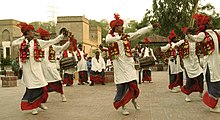
- I would prefer 1 instead of 3 (Women with dupatta.jpg) since it is a frontal image of the group of ladies. The group of Men in Bangalore is also good. the pic of child in Lungi is again not a representational pic of Indian dressing. --DBigXrayᗙ 13:00, 6 January 2019 (UTC)
New Images - Cuisine
- Rotate

- Images
-
South Indian style vegetarian thali served in a restaurant.
-
North Indian style vegetarian thali served in a restaurant.
-
Rajasthani style vegetarian thali served in a restaurant.
-
Gujarati style vegetarian thali served in a restaurant.
-
Assamese style thali served in a restaurant.
-
Andhra style vegetarian thali served in a restaurant.
-
Karnataka style vegetarian thali served in a restaurant.
-
Bengali style thali served in a restaurant.
-
Sikkimese style thali served in a restaurant.
-
Punjabi style vegetarian thali served in a restaurant.
Support or Oppose
- Support: The rotating image provides value to section. (Highpeaks35 (talk) 02:34, 2 January 2019 (UTC))
- Oppose Again, unbridled nonsense. Why the surfeit of "vegetarian thalis?" What percentage of Indians are vegetarians and go to a restaurant to order vegetarian thalis. What is in these thalis? Is it explained? If not, how is that information encyclopedic? (The trader castes of North India, particularly fussy about food to the extent of avoiding onions and garlic, hardly ever eat out.) At least the previous images are not the cheap, quick, ones lifted from restaurants. Besides, where is the Goan beef curry, the Dalit pork curry, the Muslim Kalia or the pasanda, the mutton/buffalo nehari, the Hyderabadi mutton biryani? The Bengali or Assamese fish dishes? Strongly object to one editor flooding this page with information-less images. Fowler&fowler«Talk» 22:10, 2 January 2019 (UTC)
- Oppose Fowler's views are spot on here. here is the article with the numbers. Vegetarian India A Myth? Survey Shows Over 70% Indians Eat Non-Veg, Telangana Tops List The list above has been cherry picked for vegetarian food with complete disregard to the figures and eating habits of 70% of Indians. It might have been inadvertent but the images selected does not adequately represent Indian cuisine. --DBigXrayᗙ 13:23, 3 January 2019 (UTC)
- DBigXray, the Assamese, Sikkimese, and Bengali thalis are non-vegetarian. (Highpeaks35 (talk) 01:32, 4 January 2019 (UTC))
- Oppose The images don't in any form what so ever encompass the length and breadth of the Indian cuisine. Most of the thali's here are typical of those served in restaurants not belonging to the region which the thali is said to represent. Just looking at the Bengali thali tells me that there are five? meat dishes whereas a typical bengali meal contains only one. The Rajasthani thali is served in styrofoam plates coated with a silver lining? To top all of that of, the picture quality is horrible as is the captions which don't at all explain the components of the thali properly. — fr ❄ 05:14, 4 January 2019 (UTC)
- Oppose - this is all restaurant dishes. See commons.wikimedia.org/wiki/Category:Food_of_India.
- Comment I have now loaded all the images currently in the article in the subpage User:Fowler&fowler/Images in FA India. There are a total of 71 images in the article, including ten Featured Pictures. Many pictures are part of a rotating stack, so you won't see them all the time. The rotation was originally cyclic, incrementing by one every day. However a few years ago someone, without any discussion, changed it to random rotation, which means that the images are chosen randomly in the stack. Therefore, you might see the same image on two consecutive days, or you might not see it for many days, more days than there are images. I have pinged the editor who did this, and, in the absence of a reply, will be changing it back to cyclic rotation. Anyway, I have the sense that many editors are not aware of the full range of images that are already in the article. Please take a look at those images, and make your suggestions in the context of what is there. Please note that clothes, some beautiful ones, appear in many of these pictures. If you want some images removed, please make those suggestions too, suggesting replacements. I will soon be creating another subpage consisting of Wikipedia India-related featured pictures that are not already in the article. Once that page will be ready, there will be more choices available. Best regards, Fowler&fowler«Talk» 22:24, 6 January 2019 (UTC)
- Comment hi all, I would like to draw the attention of the users to Wikipedia:WikiProject_India/Indian_cuisine_personal_user_awards#top which contains some very nice pictures of Indian cuisine that are fit for an FA article. Please take a look and include some of them. At the very least please make sure to include this Tandoori Chicken pic. regards --DBigXrayᗙ 20:23, 7 January 2019 (UTC)
- Dear @DBigXray:, Those are excellent pictures, and show individual dishes. I can't decide though if they are pictures of restaurant food or include home food as well, in the way that @Joshua Jonathan:'s pictures do, or as one-half of the picture currently in the article does. We have to strike a balance between the different forms of available food, special occasions food, peasant food, home food, restaurant food, and so forth, but you've given us a lot to think about. Best regards, Fowler&fowler«Talk» 21:18, 7 January 2019 (UTC)
New Images - Literature
- Rotate
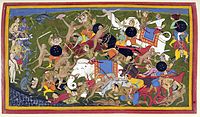
- Images
-
A manuscript illustration of the Battle of Kurukshetra, fought between the Kauravas and the Pandavas, recorded in the Mahābhārata.
-
The Battle at Lanka, Ramayana by Sahibdin. It depicts the monkey army of the protagonist Rama (top left, blue figure) fighting Ravana—the demon-king of the Lanka—to save Rama's kidnapped wife, Sita. The painting depicts multiple events in the battle against the three-headed demon general Trisiras, in the bottom left. Trisiras is beheaded by Hanuman, the monkey-companion of Rama.
-
Rama and Hanuman fighting Ravana from Ramavataram, an album painting on paper from Tamil Nadu, c. 1820 CE.
Support or Oppose
- Support: The rotating image provides value to section. (Highpeaks35 (talk) 02:34, 2 January 2019 (UTC))
- Object strongly to all. All poor quality. All are pictures from texts. No explanation of what the texts say. Fowler&fowler«Talk» 22:24, 2 January 2019 (UTC)
- Oppose all. 3 pics from Ramayana-Mahabharata and one Tamil author, again a very poorly thought selection of images. The nominator has not explained any kind of justification for this selection and appears to me be done without much thoughts.--DBigXrayᗙ 13:27, 3 January 2019 (UTC)
- Support - follow the text, and give illustrations to the text. Tghe illustratins above seem okay to me. Joshua Jonathan -Let's talk! 06:12, 5 January 2019 (UTC)
- Comment I have now loaded all the images currently in the article in the subpage User:Fowler&fowler/Images in FA India. There are a total of 71 images in the article, including ten Featured Pictures. Many pictures are part of a rotating stack, so you won't see them all the time. The rotation was originally cyclic, incrementing by one every day. However a few years ago someone, without any discussion, changed it to random rotation, which means that the images are chosen randomly in the stack. Therefore, you might see the same image on two consecutive days, or you might not see it for many days, more days than there are images. I have pinged the editor who did this, and, in the absence of a reply, will be changing it back to cyclic rotation. Anyway, I have the sense that many editors are not aware of the full range of images that are already in the article. Please take a look at those images, and make your suggestions in the context of what is there. Please note that clothes, some beautiful ones, appear in many of these pictures. If you want some images removed, please make those suggestions too, suggesting replacements. I will soon be creating another subpage consisting of Wikipedia India-related featured pictures that are not already in the article. Once that page will be ready, there will be more choices available. Best regards, Fowler&fowler«Talk» 22:25, 6 January 2019 (UTC)
New Images - Architecture
- Rotate
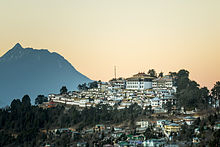
- Images
-
Ashoka pillar at Vaishali, 250 BCE.
-
Sanchi Stupa No.2, the earliest known stupa with important displays of decorative reliefs, circa 125 BCE.[3]
-
Martand Sun Temple Central shrine, dedicated to the deity Surya.
-
Kakatiya Kala Thoranam (Warangal Gate) built by the Kakatiya dynasty in ruins.
-
Chennakesava Temple is a model example of the Hoysala architecture.
-
Built during the course of the 15th century by Rana Kumbha, the walls of the fort of Kumbhalgarh claimed to be the one of the longest continuous wall.
-
Char Minar at Old City in Hyderabad.
-
A Toda tribal hut is an example of Indian vernacular architecture.
Support or Oppose
- Support: The rotating image provides value to section. (Highpeaks35 (talk) 02:34, 2 January 2019 (UTC))
- Oppose : because it does not adequately represent the Indian architecture. It is surprising to not see Taj Mahal, Red Fort, Char Minar, etc, from Islamic architecture in a list of Images that is supposed to represent Indian architecture. Again a very poorly thought selection of images. The nominator has not explained any kind of justification for this particular selection and appears to me be done without much thoughts.--DBigXrayᗙ 13:35, 3 January 2019 (UTC)
- DBigXray, Taj Mahal and Red Fort are already in the article, they provide other info like government, tourism or religion. But, we can add Char Minar or others if it makes any difference. (Highpeaks35 (talk) 01:35, 4 January 2019 (UTC))
- DBigXray, I have added Char Minar. Let me know if your vote changes. (Highpeaks35 (talk) 05:08, 6 January 2019 (UTC))
- DBigXray, Taj Mahal and Red Fort are already in the article, they provide other info like government, tourism or religion. But, we can add Char Minar or others if it makes any difference. (Highpeaks35 (talk) 01:35, 4 January 2019 (UTC))
- Support: There are very few images in the India article which represent Hindu architecture. We already have an image of Taj Mahal (which represents Islamic Mughal style) and Rashtrapati Bhawan (which represents Anglo-Indian style). Given the fact that Hindu architecture represents native Indian architectural style doing back to thousands of years, it definitely deserves representation in the article. --King Zebu (talk) 05:24, 4 January 2019 (UTC)
- Agreed. 1337 siddh (talk) 05:27, 14 January 2019 (UTC)
- Partly support - nice, but one-sided. Where's the Indian vernacular architecture? Joshua Jonathan -Let's talk! 06:16, 5 January 2019 (UTC)
- Joshua Jonathan, thanks! I think Toda Hut is a great addition. (Highpeaks35 (talk) 04:35, 6 January 2019 (UTC))
- Joshua Jonathan, I have added it above. Let me know if your vote changes. (Highpeaks35 (talk) 04:46, 6 January 2019 (UTC))
- @Joshua Jonathan:, @Highpeaks35: The Toda Hut, a Wikipedia featured picture, has been in the article for upward of ten years. It is in a rotating stack in the culture section: [[File:Toda Hut.JPG|thumb|A [[Toda people|Toda]] tribal hut exemplifies [[Indian vernacular architecture]].]]. Please note that the article already has 71 pictures. We can't add many more pictures. There are already pictures of cuisine and cooking, four or five, some with two sections, in the society section rotation group, and clothing appears in the demographic section image rotation, in the apparel worn by various diverse individuals; we can simply add the name of the clothing in the caption. These pictures already cover a wide range of clothing. Best regards, Fowler&fowler«Talk» 11:45, 6 January 2019 (UTC)
- Joshua Jonathan, I have added it above. Let me know if your vote changes. (Highpeaks35 (talk) 04:46, 6 January 2019 (UTC))
- Joshua Jonathan, thanks! I think Toda Hut is a great addition. (Highpeaks35 (talk) 04:35, 6 January 2019 (UTC))
- Comment I have now loaded all the images currently in the article in the subpage User:Fowler&fowler/Images in FA India. There are a total of 71 images in the article, including ten Featured Pictures. Many pictures are part of a rotating stack, so you won't see them all the time. The rotation was originally cyclic, incrementing by one every day. However a few years ago someone, without any discussion, changed it to random rotation, which means that the images are chosen randomly in the stack. Therefore, you might see the same image on two consecutive days, or you might not see it for many days, more days than there are images. I have pinged the editor who did this, and, in the absence of a reply, will be changing it back to cyclic rotation. Anyway, I have the sense that many editors are not aware of the full range of images that are already in the article. Please take a look at those images, and make your suggestions in the context of what is there. Please note that clothes, some beautiful ones, appear in many of these pictures. If you want some images removed, please make those suggestions too, suggesting replacements. I will soon be creating another subpage consisting of Wikipedia India-related featured pictures that are not already in the article. Once that page will be ready, there will be more choices available. Best regards, Fowler&fowler«Talk» 22:28, 6 January 2019 (UTC)
- 'Mostly support' - There needs to be more variation and images of pre-Muslim styles and also what King Zebu said earlier. 1337 siddh (talk) 05:28, 14 January 2019 (UTC)
New Images - Sports
- Rotate

- Images
-
Indian hockey team, captained by Dhyan Chand (standing second from left), after winning the finals at the 1936 Summer Olympics – their third of six consecutive Olympic golds.
-
A street-corner game of pachisi in Pushkar, Rajasthan.
-
A game of kabaddi at the Asian Games.
-
Cricket is the most popular game among India's masses. Shown here is an instance of street cricket.
-
Kalarippayattu, a martial art native to Kerala.
-
Indian chess grandmaster and former world champion Vishwanathan Anand competes at a chess tournament in 2005. Chess is commonly believed to have originated in India in the 5th century CE.
-
During a twenty four-year career, Sachin Tendulkar has set many batting records, including most runs in both tests and ODIs and most number of centuries in both tests and ODIs, making him one of the most successful cricketers ever.
Support or Oppose
- Support: The rotating image provides value to section. (Highpeaks35 (talk) 02:34, 2 January 2019 (UTC))
- Oppose any new additions. See below. Fowler&fowler«Talk» 00:06, 3 January 2019 (UTC)
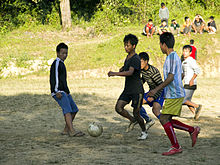
1.This informative picture of boys playing soccer in Manipur has been replaced by a shabby image of an empty field, which is claimed to be an old polo field. No kidding. Fowler&fowler«Talk» 00:06, 3 January 2019 (UTC)
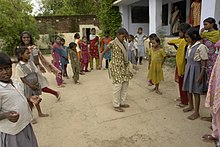
2.This beautiful picture of girls playing hopscotch in Madhya Pradesh has been removed.

3. This beautiful picture has been replaced by a postage stamp resolution type picture of a bunch of skinny men playing kabaddi.
Recall, more than two thirds of India is rural. The other pictures are the same as the ones already in the stable version. Fowler&fowler«Talk» 00:06, 3 January 2019 (UTC)
- Keep as is I prefer the current set of pictures, though I feel adding a quality picture of people playing cricket wouldn't hurt. — fr ❄ 05:25, 4 January 2019 (UTC)
New Images - Motion pictures, television
- Rotate

- Images
-
Advertisement in The Times of India of 25 May 1912 announcing the screening of the first feature film of India, Shree Pundalik by Dadasaheb Torne.
-
A scene from Raja Harishchandra (1913), the first full-length Indian motion picture.
-
Producer-director-screenwriter Dadasaheb Phalke, the "father of Indian cinema".
-
AVM Studios in Chennai, India's oldest surviving film studio.
References
- ^ Rosen, Elizabeth S. (1975). "Prince ILango Adigal, Shilappadikaram (The anklet Bracelet), translated by Alain Damelou. Review". Artibus Asiae. 37 (1/2): 148–150. doi:10.2307/3250226. JSTOR 3250226.
- ^ Rosen, Elizabeth S. (1975). "Prince ILango Adigal, Shilappadikaram (The anklet Bracelet), translated by Alain Damelou. Review". Artibus Asiae. 37 (1/2): 148–150. doi:10.2307/3250226. JSTOR 3250226.
- ^ a b Didactic Narration: Jataka Iconography in Dunhuang with a Catalogue of Jataka Representations in China, Alexander Peter Bell, LIT Verlag Münster, 2000 p.15ff
Support or Oppose
- Support: The rotating image provides value to section. (Highpeaks35 (talk) 02:34, 2 January 2019 (UTC))
- Oppose : don't agree with this set of images because it does not adequately represent the indian cinema/TV industry. All the images are very old. --DBigXrayᗙ 13:54, 3 January 2019 (UTC)
Comments
- Any reason why we need more images the article appears to have enough already. MilborneOne (talk) 00:28, 2 January 2019 (UTC)
- These are rotating images for each section. These sections above are blank without any images and having one rotating image provide the reader with an added value. I am not proposing we have several images per section, just one rotating image which adds value - as mentioned, just the noted sections above which do not have any image. (Highpeaks35 (talk) 00:36, 2 January 2019 (UTC))
- OK but I object to the new images, I dont think we need any more and commons is available to those interested. Some of the section are just overviews that already have image filled articles linked. MilborneOne (talk) 00:40, 2 January 2019 (UTC)
- @MilborneOne: Understood, but, let me know if you find any of the above rotating galleries useful to their respected section. Or you object to all of it? (Highpeaks35 (talk) 00:43, 2 January 2019 (UTC))
- I personally think we should have something for sports and clothing, at least. But, that is just me. We obviously need to agree as a community. :) (Highpeaks35 (talk) 00:45, 2 January 2019 (UTC))
- OK but I object to the new images, I dont think we need any more and commons is available to those interested. Some of the section are just overviews that already have image filled articles linked. MilborneOne (talk) 00:40, 2 January 2019 (UTC)
- These are rotating images for each section. These sections above are blank without any images and having one rotating image provide the reader with an added value. I am not proposing we have several images per section, just one rotating image which adds value - as mentioned, just the noted sections above which do not have any image. (Highpeaks35 (talk) 00:36, 2 January 2019 (UTC))
Agree with @MilborneOne: We don't need new images, especially not adolescent touristy ones. India is not an industrialized power, at least the industrialization has not brought uniform wealth; otherwise India's rank in the list of countries by per capita income wouldn't still be 140 out of 180, just a few ranks above Pakistan and well below Sri Lanka and Bhutan. India is still a largely rural country. The percentage of Indians living in rural areas per the last census was 69%, some 3% below the previous census, but still more than two thirds. None of the images I see upstairs are of any worth for an FA. Recall, for those who remember, there was a time when only Featured Pictures were fielded in India, Wikipedia's oldest country featured article. We can't let it go to dogs on somebody's whim or fantasy. Fowler&fowler«Talk» 01:49, 2 January 2019 (UTC)
- We certainly can't have pictures of a bunch of so-called Rajputs dressed up at a wedding, with caption: "Achkan sherwani and churidar (lower body) worn by Maharaja Arvind Singh Mewar and his kin during a Hindu wedding in Rajasthan, India." What Maharaja? The privileges, titles, and remuneration to the former rulers of princely states were abolished in 1971. And this fellow is a distant relative. He was the manager of the Lake Palace Hotel in Udaipur, where the Ambani's had Beyonce perform recently. Might as well have a picture of Beyonce in Indian outfit. Fowler&fowler«Talk» 01:59, 2 January 2019 (UTC)
- PS I mean we can't have that picture on Wikipedia, let alone an FA. Please someone, delete it from WP, and the Maharaja's page as well. Fowler&fowler«Talk» 02:01, 2 January 2019 (UTC)
- @Fowler&fowler: If Maharaja's sherwani picture does not meet FA, that is fine. We can remove it. That is the type of discussion we need to have, not edit warring. (Highpeaks35 (talk) 02:08, 2 January 2019 (UTC))
- But you can't load pictures or text en mass as you have been doing in a Featured Article and then expect us to clean up your mess one item at a time. Similarly, please revert the textual mess you have created in the lead and the history and (probably) other sections to the stable version of RegentsPark. Then bring them up here for discussion one at a time (not in a big data dump). Fowler&fowler«Talk» 02:16, 2 January 2019 (UTC)
- One thing at a time. It will get done. Also, what does industrialization have to do with the above? Those images are mainly about culture - not economy, per se. I think you are bringing User:King Zebu edits as well. But, those were accepted awile back by consensus. (Highpeaks35 (talk) 02:18, 2 January 2019 (UTC))
- The textual edits were certainly weren't accepted by RegentsPark as I reverted to his reversion. Sorry, I can't discuss a image dump. All your images are poor quality. Fowler&fowler«Talk» 02:27, 2 January 2019 (UTC)
- That is certainly fine. Let other editors comment. Thank you for giving your input, instead of edit warring. (Highpeaks35 (talk) 02:29, 2 January 2019 (UTC))
- The textual edits were certainly weren't accepted by RegentsPark as I reverted to his reversion. Sorry, I can't discuss a image dump. All your images are poor quality. Fowler&fowler«Talk» 02:27, 2 January 2019 (UTC)
- One thing at a time. It will get done. Also, what does industrialization have to do with the above? Those images are mainly about culture - not economy, per se. I think you are bringing User:King Zebu edits as well. But, those were accepted awile back by consensus. (Highpeaks35 (talk) 02:18, 2 January 2019 (UTC))
- But you can't load pictures or text en mass as you have been doing in a Featured Article and then expect us to clean up your mess one item at a time. Similarly, please revert the textual mess you have created in the lead and the history and (probably) other sections to the stable version of RegentsPark. Then bring them up here for discussion one at a time (not in a big data dump). Fowler&fowler«Talk» 02:16, 2 January 2019 (UTC)
- @Fowler&fowler: If Maharaja's sherwani picture does not meet FA, that is fine. We can remove it. That is the type of discussion we need to have, not edit warring. (Highpeaks35 (talk) 02:08, 2 January 2019 (UTC))
- PS I mean we can't have that picture on Wikipedia, let alone an FA. Please someone, delete it from WP, and the Maharaja's page as well. Fowler&fowler«Talk» 02:01, 2 January 2019 (UTC)
I'm still waiting for you to revert the text to the last stable version of RegentsPark. I don't see any consensus for the textual edits, to the poor language, exaggerated tone, etc. If you push your luck too much, I'll put it on FAR and have the FA status removed, and then you and your cohorts can work on a sinking ship all you want. Fowler&fowler«Talk» 02:35, 2 January 2019 (UTC)
- We will move as we build consensus, not by your impatience. You do what needs to be done, however, I am not responsible for all the edits for the last year. (Highpeaks35 (talk) 02:38, 2 January 2019 (UTC))
- I'm not a fan of the rotating image scheme in general, as it's apt to leave people mystified when they return to an article and can't find a photo they remember being there. Stick with a single good, representative picture, if you need one, and depend on people following links to articles on dress or cuisine, etc., to find illustrations there. Dhtwiki (talk) 00:36, 4 January 2019 (UTC)
- We will move as we build consensus, not by your impatience. You do what needs to be done, however, I am not responsible for all the edits for the last year. (Highpeaks35 (talk) 02:38, 2 January 2019 (UTC))
Currently the 'Geography' section of the article has a picture of the Himalayas next to prose about the Indian coastline... That's concerning given how beautiful the coasts are. Also why the 'Economy' section has two(?) gloomy pictures of rice fields is beyond me. Or why the 'Sports' section has a picture of a martial art (not a sport).
Perhaps drop this posturing about rotating images and collaborate on restoring or adding the best images to the article; maybe even try to find room for one or two more. Cesdeva (talk) 02:17, 5 January 2019 (UTC)
- Comment I have now loaded all the images currently in the article in the subpage User:Fowler&fowler/Images in FA India. There are a total of 71 images in the article, including ten Featured Pictures. Many pictures are part of a rotating stack, so you won't see them all the time. The rotation was originally cyclic, incrementing by one every day. However a few years ago someone, without any discussion, changed it to random rotation, which means that the images are chosen randomly in the stack. Therefore, you might see the same image on two consecutive days, or you might not see it for many days, more days than there are images. I have pinged the editor who did this, and, in the absence of a reply, will be changing it back to cyclic rotation. Anyway, I have the sense that many editors are not aware of the full range of images that are already in the article. Please take a look at those images, and make your suggestions in the context of what is there. Please note that clothes, some beautiful ones, appear in many of these pictures. If you want some images removed, please make those suggestions too, suggesting replacements. I will soon be creating another subpage consisting of Wikipedia India-related featured pictures that are not already in the article. Once that page will be ready, there will be more choices available. Best regards, Fowler&fowler«Talk» 22:29, 6 January 2019 (UTC)
Realism versus airbrushing in images, real or metaphorical


This page has had a picture of the Delhi metro, and the bus transportation below, as an example of infrastructure development. user:King Zebu has attempted to change it to a picture of a empty, clean, metro station with train steaming in, or perhaps out, with this accompanying rationale: (Old image) "The image is so crowded. The subjects of the caption (CNG buses and Metro) are not in focus. Very bad image." (New Image) "The subject is the focus of the image."
But the subject of the first picture is really as much about "Infrastructure," the elevated concrete platforms supported by pillars for the trains, the roads below, that have made the systems operational. The concrete is very much in focus; as is the orange bus and pavement below (you can read the license plate number). The crowds are fairly normal for a metro station in Delhi. As for the new image, it shows a Bombardier Transportation train built in Canada (the filename is: DelhiMetroBlueLineBombardier), purchased by India, steaming into a empty, clean, station. What is the picture a representation of? Canadian technology? Or of a generic train station, for if you did not notice something written in Devanagari on the top left corner, you would have little idea of where the picture was taken. In other words, even when you are showing modern sectors of the economy, you have to show them in the context of India, with its crowds, chaotic traffic, litter on the street, and so forth, in order to be encyclopedic. Otherwise, you would be providing false visual information. You can't have images of the shining India in an encyclopedia, i.e. pictures taken out of the usual context in order to burnish the country's reality. I'm not saying that the first image is perfect. But the second clearly distorts the reality. Fowler&fowler«Talk» 17:14, 4 January 2019 (UTC)
- Fowler&fowler (talk · contribs) This is what I mean by selective bias. Have you seen NYC article? Regarding its metro? There are tons of trash, rats and litter, but you see images of a well kept metro on the article. Which is correct? As, the focus is on the metro. And in cases, both Delhi metro or NYC metro both are well kept or not so in others. Why not put a picture of rats and trash in NYC metro? Riders of NYC metro see it everyday? You are just pushing your bias with Indian crowds, trash, etc. and forgetting, this is seen in any populated country. Regardless, if it is rich as USA or UK, or developing like India or Mexico. Rwanda is poor, but it’s Capital was the cleanest city I ever visited, but it is small nation with small population. (Highpeaks35 (talk) 17:40, 4 January 2019 (UTC))
- Agreed. 1337 siddh (talk) 05:34, 14 January 2019 (UTC)
- Fowler&fowler (talk · contribs) This is what I mean by selective bias. Have you seen NYC article? Regarding its metro? There are tons of trash, rats and litter, but you see images of a well kept metro on the article. Which is correct? As, the focus is on the metro. And in cases, both Delhi metro or NYC metro both are well kept or not so in others. Why not put a picture of rats and trash in NYC metro? Riders of NYC metro see it everyday? You are just pushing your bias with Indian crowds, trash, etc. and forgetting, this is seen in any populated country. Regardless, if it is rich as USA or UK, or developing like India or Mexico. Rwanda is poor, but it’s Capital was the cleanest city I ever visited, but it is small nation with small population. (Highpeaks35 (talk) 17:40, 4 January 2019 (UTC))
- This very concern raised by Fowler is a clear reflection of his hidden bias and agenda. Pick up the ugliest image of a crowded Indian street and showcase it as some sort of poverty porn. The other picture (which was added after achieving Consensus on this talkpage) was taken at 9:02pm (as evident from the platform clock in the image) - which is an off-peak time is less crowded. It is perfect because the focus remains on the Metro, not on anything else. It is not "empty" as passengers are clearly visible in background. But yeah, some people air-brush images, some people air-brush facts. --King Zebu (talk) 18:57, 4 January 2019 (UTC)
Editing India's official name in Devnagari Script
I request the Wikipedia editors to edit the official name of Indian in Hindi from romanticized version to Devnagri Scipt as भारतीय गणराज्य .All other nations in wikipedia pages have thier official names written in 2 or more languages one is english and others in official languages. So since Hindi is also the official language of India , the official name should also be written in Hindi. Now previously one the editor showed concern regarding large linguistic diversity in india.But that cant be any reason to block my request.It is not a legit argument.Many people speak languages other than English in UK but that doesnt mean thier page have thier offial name in Other than in English Srijanx22 (talk) 11:13, 6 January 2019 (UTC)
- Please read Frequently asked questions at the top of the page. MilborneOne (talk) 15:59, 6 January 2019 (UTC)
- Which page? There's no FAQ in this talk page. Regardless, the Devanagari version should be present, as it is one of the official language of India. 1337 siddh (talk) 05:50, 14 January 2019 (UTC)
- Support : Yes, the Devanagari version should be there. Absence of it is wierd considering Hindi is one of the two official languages of India. 1337 siddh (talk) 05:50, 14 January 2019 (UTC)
- Again: Please read Frequently asked questions at the top of the page (labelled Frequently asked questions (FAQ)). Bazza (talk) 10:24, 14 January 2019 (UTC)
Numbering system
Following on from this and subsequent edits, the discussion below has been copied from User_talk:Azuredivay#Your_edits_to_India to encourage wider consensus following temporary protection from editing.
Please read Wikipedia:Manual_of_Style#Opportunities for commonality. It will be better if you get yourself familiarized with Wikipedia guidelines. Also, what part of "discuss this further in talkpage" did you not understand? You should wait for my response atleast before engaging in revert war. --King Zebu (talk) 05:32, 16 December 2018 (UTC)
I did, wiki guidelines do mention context, and in the context of the topic of the article, the numbering does make sense, and I add links to alternate numbering. As for reverts, I did as you did, I wouldn't want people to be devoid of information due to your delay in deciding what you think if the right way to write.
- Wiki guidelines at MOS:NUMERAL also mention "Group digits in Western thousands-based style (e.g., 30,000,000; not 3,00,00,000)", which you have ignored again. Please read the manual of style properly before editing further, especially the item stating "Sometimes, the variety of English used in an article may suggest the use of a numbering system other than the Western thousands-based system. For example, the South Asian numbering system is conventionally used for certain things (especially monetary amounts) in South Asian English. This is discouraged in Wikipedia articles by Wikipedia:Manual_of_Style#Opportunities_for_commonality." Bazza (talk) 10:57, 18 December 2018 (UTC)
Discouraged, not disallowed.
- Indeed. And Wikipedia:Manual_of_Style#Opportunities_for_commonality goes on to say "Use universally accepted terms rather than those less widely distributed, especially in titles. For example, glasses is preferred to the national varieties spectacles (British English) and eyeglasses (American English); ten million is preferable to one crore (Indian English)." It also adds "When an English variety's consistent usage has been established in an article, maintain it in the absence of consensus to the contrary.", which is not what you have been doing. Also, "With few exceptions (e.g., when a topic has strong national ties or a term/spelling carries less ambiguity), there is no valid reason for such a change.": the South Asian numbering system is not less ambiguous or clear to the majority of English Wikipedia readers, many of whom may not have English as their first language, nor any familiarity with the numbering system concerned.
It is good to see that you have refrained from further disruption.Bazza (talk) 13:26, 18 December 2018 (UTC)- It looks like I've assumed good faith which you have not earned, and you are still disruptively editing. I've struck out my previous comment. Bazza (talk) 13:36, 18 December 2018 (UTC)
Please do not name it 'disruption' when it isn't withholding information. I'm stating both numbering systems with links to both, seeing how it's an article on India, I'll stick to it being written in both Indian numbering system and the other one.
- But you are not doing that. You have repeatedly used two-digit groupings for large numbers (such as population); you redid your change which was reverted with a request (from User:King Zebu) to discuss first which you ignored. You have also ignored the instructions "When an English variety's consistent usage has been established in an article, maintain it in the absence of consensus to the contrary." which I referred to above. That is disruption. Bazza (talk) 15:02, 18 December 2018 (UTC)
And you say this while you're ignoring that if those were the violating edits, why were all of my crore (million) edits were removed too. That said, I could do the same with comma separated numbers with INS(Other NS) if that helps my edit be more in line with Wikipedia standards
- Pressing "undo" reverts everything in an edit. It's more likely to happen if you make many changes in the same edit; do not provide any useful information in the edit summary; and do not engage in discussion when asked. Having large numeric values specified twice in two different formats is not acceptable: you should use three-digit separation only as specified at MOS:NUMERAL. Your primary use of uncommon number names (such as crore and lakh) ignores Wikipedia:Manual_of_Style#Opportunities_for_commonality. And you are making all these changes in defiance of "When an English variety's consistent usage has been established in an article, maintain it in the absence of consensus to the contrary." I do not understand why you persevere in this behaviour. If you do not like the MOS standards then petition to get them changed to suit your preferences rather than persistently edit disruptively. Bazza (talk) 15:36, 18 December 2018 (UTC)
I did provide that information previously, until all of them were ignored. That said, I intend to keep it in Indian numbering system seeing how the article is indeed written in "Indian English" which sees those words as dictionary words.
End of copy Bazza (talk) 10:46, 20 December 2018 (UTC)
Restoring last good version
I suggested to the protecting admin, CambridgeBayWeather, that reverting the disruptive addition was important, especially since there is erroneous information, some of which is in the lead. No action was promised or has been forthcoming. Is it worth trying to get someone to revert before Wednesday, December 26? Dhtwiki (talk) 03:14, 21 December 2018 (UTC)
- What are we referring to when we say "erroneous" information? — Preceding unsigned comment added by Azuredivay (talk • contribs) 07:34, 21 December 2018 (UTC)
- I put the errors in my post on CambridgeBayWeather's user talk page. IIRC, the lead says that India has a population of 1,200 crore, which equals 12 billion. There's also one other erroneous conversion, farther down, in a section on geological origins, where 7.5 lakh equals 75 million, where obviously crore is meant. Not huge errors, but, esp. the first, apt to puzzle some people and make them wonder at why the article is a featured one. Add to that all the odd usage of digit separators, which is practically unique on WP, although in line with Indian usage. Dhtwiki (talk) 00:41, 22 December 2018 (UTC)
- All you need for a change is a few people agreeing to it on this talk page. Then use {{edit protected}} — Martin (MSGJ · talk) 09:05, 21 December 2018 (UTC)
- This protection is a good example of disruptive mindless administration. I don't know why people feel the need to administer something without doing any proper analysis of the problem.--ThaThinThaKiThaTha (talk) 09:32, 21 December 2018 (UTC)
- The article's improvement was going nowhere. Protecting it for a short period has given a breathing space for calming down, and time for the discussion to be moved from the disruptive editor's talk page to the article's talk page so more people can participate, which seems to have worked. Bazza (talk) 10:00, 21 December 2018 (UTC)
- I don't see any discussion regarding content. This discussion is about the protection policy, not about the content.--ThaThinThaKiThaTha (talk) 10:32, 21 December 2018 (UTC)
- This discussion falls under the heading "Numbering system", the first part of which arose from disruptive content changes. This subsection is about the protection which was applied as a result of those changes. You commented that the protection was applied without due thought to the problem at hand. I disagreed with that because I think the protection has served its purpose, frustrating though it is to the editors involved, including me. I never mentioned "content", only the protection process which has been gone through in this instance. If you are making general comments about protection policies, there are probably better places to get a more productive discussion than on the India article's talk page. Bazza (talk) 10:48, 21 December 2018 (UTC)
- I don't see any discussion regarding content. This discussion is about the protection policy, not about the content.--ThaThinThaKiThaTha (talk) 10:32, 21 December 2018 (UTC)
- The article's improvement was going nowhere. Protecting it for a short period has given a breathing space for calming down, and time for the discussion to be moved from the disruptive editor's talk page to the article's talk page so more people can participate, which seems to have worked. Bazza (talk) 10:00, 21 December 2018 (UTC)
I hope we stick to the current edit with Indian numbering system in parallel to the more common one used throughout wiki, as the words are part of Indian English that the page is written in, and add more information without withholding anything or giving any wrong information - Azuredivay — Preceding unsigned comment added by Azuredivay (talk • contribs) 20:42, 21 December 2018 (UTC)
- This article is not to be confused with Indian English, where your content may have a valid place. This article is not about Indian English, but about India, the country. I don't see any evidence of that this article has been written in Indian English?! --ThaThinThaKiThaTha (talk) 22:40, 21 December 2018 (UTC)
Read the top, the article IS in Indian English, with local numbering making more sense to local readers, for other readers the other numbering is provided as well. This serves more people as more understand the context and gravity of what is being talked about. - Azuredivay — Preceding unsigned comment added by Azuredivay (talk • contribs) 13:43, 22 December 2018 (UTC)
- Mr. Azure, firstly please sign your comments on talkpages. Secondly, I urge you to look at the other side of the coin. While you do have a point in promoting Indian numbering system, especially on India-related articles - your strategy of including both Indian and Western numbering system is flawed. Including both numeral systems unnecessarily lengthens the text and creates more confusion. It doesn't add ANY value to the article and besides, vast majority of English-speaking Indians are anyways aware of Western numbering system (millions & billions vs. lakhs & crores). This the main India article and needs to be to-the-point. Tomorrow, someone will start pushing Hinglish in an attempt to "make sense to local readers". Please provide evidence to backup your claim that English-speaking Indians cannot make sense of millions and billions. Lastly, Wikipedia policy clearly discourages usage of inconsistent terminologies and since the vast consensus here is against your proposed changes, maybe you should take a rest. --King Zebu (talk) 08:22, 23 December 2018 (UTC)
- I thought there was a policy or guideline that explicitly mentioned idiosyncratic Indian numerical expressions as exceptions to adhering to Indian English in an article but could not find such. If there is one, perhaps it could be pointed out. Dhtwiki (talk) 23:31, 23 December 2018 (UTC)
- MOS:NUMERAL states "Sometimes, the variety of English used in an article may suggest the use of a numbering system other than the Western thousands-based system. For example, the South Asian numbering system is conventionally used for certain things (especially monetary amounts) in South Asian English. This is discouraged in Wikipedia articles by WP:Manual of Style § Opportunities for commonality.", and provides some more instructions including "Group digits in Western thousands-based style (e.g., 30,000,000; not 3,00,00,000)". Bazza (talk) 11:27, 24 December 2018 (UTC)
- That must be it. Thank you. Dhtwiki (talk) 23:46, 24 December 2018 (UTC)
- MOS:NUMERAL states "Sometimes, the variety of English used in an article may suggest the use of a numbering system other than the Western thousands-based system. For example, the South Asian numbering system is conventionally used for certain things (especially monetary amounts) in South Asian English. This is discouraged in Wikipedia articles by WP:Manual of Style § Opportunities for commonality.", and provides some more instructions including "Group digits in Western thousands-based style (e.g., 30,000,000; not 3,00,00,000)". Bazza (talk) 11:27, 24 December 2018 (UTC)
Having being educated in India for the most part, I know western numbering is a part of CBSE's curriculum which is followed by most Indian schools, it Is not the numbering we use in Maths/English, anything beyond knowing that "this is what western numbering is and this is how you can convert". My sole reason for this change is the fact that me, like most other Indian readers, spend a big chunk of our time converting millions to lakhs/crores as the former does not accurately show the "gravity" of the number in question. That said, my intention of having both numbering system does NOT increase the article length to the point where it is disruptive to read. And it does help more readers understand what is being talked about. - Azuredivay — Preceding unsigned comment added by Azuredivay (talk • contribs) 16:21, 26 December 2018 (UTC)
- What is disruptive is that your conversions were wrong in at least two instances and there have been two or three posts here, outside those of the regular group, trying to correct one of them. Never mind your obstinacy in thinking the article should be the way you want it, in spite of those who should have alerted you to the fact that your point of view is an unusual one and never mind the full protection of one of the most frequently accessed articles on Wikipedia, which I think may be unique in my experience. Dhtwiki (talk) 23:01, 26 December 2018 (UTC)
Languages spoken in India:
Malayalam language from Kerala Tamil language from Tamil Nadu Hindi India's national language Marathi language from Maharashtra Telungu language from Andhra Pradesh Punjabi language from Punjab Bengali language from West Bengal Kannada language from Karnataka — Preceding unsigned comment added by I 1!WOW (talk • contribs) 14:14, 15 January 2019 (UTC)
Semi-protected edit request on 15 January 2019
This edit request to India has been answered. Set the |answered= or |ans= parameter to no to reactivate your request. |
Let me edit India I 1!WOW (talk) 14:06, 15 January 2019 (UTC)
 Not done: It is not possible for individual users to be granted permission to edit a semi-protected article. You can do one of the following:
Not done: It is not possible for individual users to be granted permission to edit a semi-protected article. You can do one of the following:
- You will be able to edit this article without restriction four days after account registration if you make at least 10 constructive edits to other articles.
- You can request the article be unprotected at this page. To do this, you need to provide a valid rationale that refutes the original reason for protection.
- You can provide a specific request to edit the article in "change X to Y" format on this talk page and an editor who is not blocked from editing the article will determine if the requested edit is appropriate.
- Thanks, ‑‑ElHef (Meep?) 14:51, 15 January 2019 (UTC)
Semi-protected edit request on 15 January 2019
This edit request to India has been answered. Set the |answered= or |ans= parameter to no to reactivate your request. |
Change "The earliest authenticated human remains in South Asia date to about 30,000 years ago." to "The earliest known human remains in South Asia date to about 30,000 years ago." Less wonky. ..... Sahil dhara ..... (talk) 14:52, 15 January 2019 (UTC)
 Done. –Deacon Vorbis (carbon • videos) 00:57, 16 January 2019 (UTC)
Done. –Deacon Vorbis (carbon • videos) 00:57, 16 January 2019 (UTC)
Semi-protected edit request on 16 January 2019
This edit request to India has been answered. Set the |answered= or |ans= parameter to no to reactivate your request. |
Sorry to bother you again, but I noticed that under the History > Modern India section, there is a floating bullet point underneath the header with a link to History of the Republic of India. Shouldn't it also be like the other section, i.e. something like Main article : History of the Republic of India ? Sahil D (talk) 11:42, 16 January 2019 (UTC)
 Done. Fixed with the
Done. Fixed with the {{main}}template. –Deacon Vorbis (carbon • videos) 20:26, 16 January 2019 (UTC)
Updation of images in Economy section
The images in the Economy section are too agricultural specific, despite the fact that agriculture now contributes only about 20% of India's GDP. Here are all the images currently in this section:
-
A1 A farmer in Rajasthan milks his cow. Milk is India's largest crop by economic value. Worldwide, as of 2011[update], India had the largest herds of buffalo and cattle, and was the largest producer of milk.
-
A2 Agricultural workers involved in Rice planting. Rice production in India reached 102.75 million tons in 2011–12.
-
A3Indian agriculture dates from the period 7,000–6,000 BCE, employs most of the national workforce, and is second in farm output worldwide. Above, a farmer works an ox-drawn plow in Kadmati, West Bengal.
-
A4 Fishermen on the Chinese fishing nets of Cochin. Fisheries in India is a major industry in its coastal states, employing over 14 million people. The annual catch doubled between 1990 and 2010.
-
A6 India's GDP has increased more than ten-fold after the economic reforms in 1991.
-
A7 A daily wage worker in a salt field. The average minimum wage of daily labourers is around Rs.100 per day
-
A8 Schoolchildren in Chambal, Madhya Pradesh eating a mid-day meal. The Mid-Day Meal Scheme attempts to lower rates of childhood malnutrition in India.
- Out of 8 images in this section, 5 (A1, A2, A3, A4 and A7) are related to agriculture / diary / fisheries.
- A8 is of a mid-day deal meal program. This image is a complete mis-fit for this section.
- As evident, the data in caption of most of these images is highly outdated -- from way back in 2010-11.
-
P1 Agricultural workers in Tamilnadu involved in rice planting
- If the near domination of agriculture in Section 1 wasn't enough, we have another image on paddy cultivation.
-
B1 The Bombay Stock Exchange is Asia's oldest and India's largest bourse by market capitalisation.
-
B2 Tidel Park, the then largest IT park in Asia when it was opened in 2000.
-
B3 The Delhi Metro rapid transit system and the low-floor CNG buses. Infrastructure in India in the next five years is estimated to bring in $1 trillion in investment, half of it by India's private sector.
-
B4 India has the world's second-largest mobile phone user base of 996.66 million users as of September 2015[update]. Shown here is a rooftop mobile phone tower in Bangalore
-
B5 A vegetable retailer in Tamil Nadu. More than 95% of retail industry in India is unorganised.
-
B6 New under-construction units of Kakrapar Atomic Power Stationin Gujarat. The electricity sector in India has an installed capacity of 346.05 Gigawatt (GW), the world's third largest. Coal-fired plants account for 56% of India's electricity capacity.
-
B8 A container ship at Jawaharlal Nehru Port, Mumbai. International trade accounted for 14% of India's GDP in 1988, 24% in 1998, and 53% in 2008.
- B5 Another image representing agricultural sector
- B4 This is just a mobile tower. How is this image adding any value?
- B3 The image is so crowded. The subjects of the caption (CNG buses and Metro) are not in focus. Very bad image.
I hope that the veteran Wikipedians would understand the point I am wanting to make here. The images badly need an upgrade to accurately depict the rapid industralization of Indian economy, especially in the past 10 years. --King Zebu (talk) 07:04, 2 December 2018 (UTC)
New Images - Proposal #1
-
N1: Replacement for B3 The subject is the focus of the image
-
N3 Propose as replacement for A1. A high quality image which showcases industralization of diary processing sector in India.
-
N4 Propose as replacement for B4. Much more relevant and informative, as compared to just showing a mobile tower. Showcases India's rapidly growing education and training sector which in turn supports India's massive information technology and business process management sector.
-
N5 Propose as replacement for B5. India's organised retail sector deserves to represented because it is growing by 20-25% annually and will reach 18-20% of the total sector by 2020. [1]
-
N6 Propose as replacement for A3 There are no images representing India's industrial sector and the agricultural sector is over-represented.
-
N7 replacement for B2 Infosys Leadership Institute in Bangalore. Apart from representing one of India's premier IT companies, this image also highlights Bangalore, the IT hub of India and one of its largest cities.
-
N8 replacement for A5 There is no image representing science and technology in India and no mention of India's growing role in space launch industry. Besides, A5 is a poor quality and again, the subject is not in focus but is rather in the background.
--King Zebu (talk) 07:46, 2 December 2018 (UTC)
- I support these image replacement proposals, but N2 doesn't look high quality too me.--ThaThinThaKiThaTha (talk) 09:48, 2 December 2018 (UTC)
- Hi, thanks for your positive response. Regarding N2, it's a graphical representation of India's exports. Several articles (such as, Canada) use these treemaps for graphical representation of a country's exports. But that said, I agree with your viewpoint that the image is not of high quality since some of the text is not readable. --King Zebu (talk) 10:15, 2 December 2018 (UTC)
- N1 for B3: Yes. N2 for P1: No. N2 is not really an image and we should use images. I agree that P1 needs replacing though. N3 for A1: No. The dairy plant is too generic where BSE is an important building. N4 for B4: Yes (nice picture!). N5 for B5: No. Again, a mall is too generic. Plus, the street vendor market is actually more representative of India than the mall. N6 for A3: No. I'm not averse to replacing the picture but we should look for something more significant. An important factory for instance. N7 for B2: Yes. N8 for A5: Yes (another nice picture). Nice work King Zebu. The pictures definitely need updating so this is very useful. --regentspark (comment) 14:24, 2 December 2018 (UTC)
- Thank you Regent for your kind words :-) Regarding N3, I wanted to replace it with A1 (and not B1) which showcases a dairy farmer milking a cow. I personally don't like A1 at all because it simply doesn't add much value. It's fine if you don't want N3, but in my humble opinion, A1 should be removed. And yes, B1 represents the BSE in Mumbai (India's financial capital) - so it definitely deserves a place in this article. --King Zebu (talk) 17:43, 2 December 2018 (UTC)
- A1 by N3 is ok (the text could say something about the modern dairy plants and the increase in milk production over the last 50 years). --regentspark (comment) 17:49, 2 December 2018 (UTC)
- Thank you Regent for your kind words :-) Regarding N3, I wanted to replace it with A1 (and not B1) which showcases a dairy farmer milking a cow. I personally don't like A1 at all because it simply doesn't add much value. It's fine if you don't want N3, but in my humble opinion, A1 should be removed. And yes, B1 represents the BSE in Mumbai (India's financial capital) - so it definitely deserves a place in this article. --King Zebu (talk) 17:43, 2 December 2018 (UTC)
It has been a week since I proposed these changes and looks like we a consensus here. So, I'll be BOLD and implement the changes. Thanks :-) --King Zebu (talk) 04:38, 9 December 2018 (UTC)
- @King Zebu: I'm sorry, some of us were away. Sorry, India is not an industrialized country. The agriculture section might contribute only 20% of the GDP, but it employs 60% of the population. It is the largest sector. In any case, services, and not industry comprises the largest chunk of GDP. As for the mechanized dairy farm, seriously, what sort of fantasy are you peddling? Here is the Economic Times, "Nearly 80 per cent of India’s milk production is contributed by small and marginal farmers, with an average herd size of one to two milching animals." See here And out of the output of 80% of India's cows, which are milked by the farmer's own hands, 34% is sold in the unorganized sector and 46% is consumed locally. Again, please don't distort. Fowler&fowler«Talk» 02:57, 3 January 2019 (UTC)
- Fowler&fowler (talk · contribs) speaking to a fellow editor with respect and good faith is the best way to move forward. Your racist, accusatory and rude attitude towards fellow editors is not acceptable. Again, I will be reporting you. Racism is not acceptable, and racist language like "Hindu garbage" like you used against me. Also note, this article is from 2015, 4 years old. During this period, India added almost 1 trillion USD in its nominal GDP. (Highpeaks35 (talk) 03:10, 3 January 2019 (UTC))
- Fowler, a clear consensus had been reached weeks ago. You can simply engage in edit-warring pleading ignorance. For every fact stated in the paras, verifiable, reliable sources were provided. You are requested to disengage from edit-warring. If you have any concerns regarding images, you are to please resolve them on the talkpage before pushing your agenda. --King Zebu (talk) 04:25, 4 January 2019 (UTC)
- Fowler, regarding your comments on India not being an industralized country - I believe that you fantasise yourself to be a greater economic expert than Mauro Guillén and Pawel Bozyk who have clearly classified India as among the newly industralized countries. Surely, the agricultural sector continues to play an important role - and why not? After all it has to support more than a fifth of the entire humanity. But to undermine the role of industrial and services sector in India is nothing short of imbecility. And let's even keep that apart, one would be a fool to assume that India became the world's fifth largest GDP in nominal terms without achieving large-scale industrialisation. And in your zeal to push your version of the article, you also reverted content updation to the Economy section wherein latest economic statistics were added - backed by VERIFIABLE, RELIABLE and LATEST sources.
And, I'm not going to claim that you are an imprudent brat (because that would be a violation of Wikipedia:No personal attacks). But going by your racist comments and past edit history, it is quite obvious that you have a clear anti-India and anti-Hindu agenda - and that explains why you push your POV under the guise of half-witted, illogical comments.--King Zebu (talk) 05:00, 4 January 2019 (UTC)
- Struck out a portion of my reply which was not in good taste. --King Zebu (talk) 06:48, 4 January 2019 (UTC)
@King Zebu: I have looked at the discussion above. The following changes seemed to have @RegentsPark:'s consent: B3 to N1, B4 to N4, B2 to N7, A5 to N8, and after initial hesitation, A1 to N3. In the interest of not holding up progress, I will make all but the last of these changes. However, please note that N1 will need to mention Bombardier Transportation, the Canadian company which manufactures these trains, as both the original caption of the image and the image filename primarily refer to Bombardier; Delhi seems to be secondary. I am however not agreeable to A1 to N3, as this is based on an erroneous reading of the sources stemming from confusion between the harvesting or production of milk and its processing. The production is almost entirely, as of 2018, done in small holder farms by hand-milking. In a section below I have exhaustively discussed this. The processing has been done in India since the late 1950s, but has lately picked up pace, as processing units procure more milk from these small holder farms. The production has increased remarkably in the last 20 years, making India the world's largest producer. Still, a large percentage of the milk is consumed locally or in the unorganized sector. Indians themselves are consuming more milk. I am however not agreeable to the textual changes in the Economy section, as they were not discussed on this talk page; indeed King Zebu edit warred with RP to reinstate his initial edit. That will need to be discussed afresh here. Yes, the Economy section needs to be revised, but it can't be done in a few hours. There are complex issues which all need to be mentioned with DUE weight. Best regards, Fowler&fowler«Talk» 13:28, 7 January 2019 (UTC)
- PS I have now made these changes. I too like N7 and N8. Kudos to King Zebu. I have also changed the rotation to one of incrementing every day, rather than randomly being picked for every user each time they logged in. Fowler&fowler«Talk» 14:04, 7 January 2019 (UTC)
New Images - Proposal #2
--King Zebu (talk) 10:31, 2 December 2018 (UTC)
- I think both the original B8 and the one you replaced it by can be replaced. But none of these are any better. N11 might work though so, if nothing better can be found, I'd go with that. --regentspark (comment) 17:27, 2 December 2018 (UTC)
- B8 was added on the fly without discussion. It is not there in the current version. N11, however, is too blurry.Fowler&fowler«Talk» 14:10, 7 January 2019 (UTC)
Good... But I want to know moreabout the northern area after partition DEBORSHI BISWAS (talk) 03:43, 26 January 2019 (UTC)
New Section for Science and Technology
Hello everyone, I would like to propose a new section for Science and Technology which would cover IPR records, Indian Space Program and other sort of notable advances.
Although well behind developed world and upper middle income economies, India maintains very high number of intellectual properties and patents per capita, ranking of academic institutions, number of Ph.D. scholars annually, high R&D budget, a highly diversified economy with relatively better rank in Economic Complexity index and a respectable rank in Global innovation index compared to any other lower middle income economy. Other significant area to cover would be Indian national space program instead of creating new section. Regards Aman (Talk) Jan 22nd,2019
- Please refer to the frequently asked questions at the top of the page where it indicates that current consensus is not to include a Science and Technology section(s). MilborneOne (talk) 09:56, 22 January 2019 (UTC)
- I say write one up here in talk and we can see what it looks likes.... frequently asked questions is very outdated and the country project no longer holds this position and encourages any section that holds benefits for our readers.... was a local consensus that didn't fly very well with the rest of the community during FA and GA reviews.--Moxy (talk) 15:25, 9 February 2019 (UTC)
Image rotation
In the new system of image rotation, the page has to be recompiled once every day for the images to change, preferably soon after the day changes (in universal time). The program picks up the current day of the year (starting with January 1 = 0, and December 31 = 364 or 365 (in a leap year). It then computes modulus of this number with respect to the number of images in the image set, and the image corresponding to that modulus is picked for display. (The old one was random, so it randomly changed (or did not change) every time anyone went to the page's URL and it was different for each editor. That clearly was no way to show the full extent of the images.) I have added a commented out date at the top of the page. If people generally remember to change that date to the current date, after the date changes in Universal Time (at the top right of the page; for example right now it is 00:54:45) the images will keep rotating. I hope this is OK. Fowler&fowler«Talk» 00:55, 22 February 2019 (UTC)
- PS I have already changed it for 22 February, so compiling it in the next 23 hours will not change the images. However, tomorrow, once the date changes in UTC, if you change the commented out date, and save your edit, or for that matter save any other edit, the images will change in each rotation set (they will increment by one). Fowler&fowler«Talk» 01:02, 22 February 2019 (UTC)
Extended-confirmed protection applied indefinitely
I have applied indefinite ECP to this article under the discretionary sanctions for all India, Pakistan and Afghanistan related topics due to vandalism still getting through despite semi-protection and a long history of disruption, poorly sourced editing, cluelessness and edit warring. The concerns raised at this discussion apply here as well and are noted, however I do not presume the outcome of that discussion. MER-C 12:35, 22 February 2019 (UTC)
Extended-confirmed-protected edit request on 26 February 2019
This edit request to India has been answered. Set the |answered= or |ans= parameter to no to reactivate your request. |
Standalone Workstation (talk) 01:57, 26 February 2019 (UTC)
 Not done: it's not clear what changes you want to be made. Please mention the specific changes in a "change X to Y" format and provide a reliable source if appropriate. Roadguy2 (talk) 02:07, 26 February 2019 (UTC)
Not done: it's not clear what changes you want to be made. Please mention the specific changes in a "change X to Y" format and provide a reliable source if appropriate. Roadguy2 (talk) 02:07, 26 February 2019 (UTC)
Extended-confirmed-protected edit request on 6 March 2019
This edit request to India has been answered. Set the |answered= or |ans= parameter to no to reactivate your request. |
2409:4063:211A:B571:0:0:2579:28A4 (talk) 05:32, 6 March 2019 (UTC)
 Not done: it's not clear what changes you want to be made. Please mention the specific changes in a "change X to Y" format and provide a reliable source if appropriate. DannyS712 (talk) 05:39, 6 March 2019 (UTC)
Not done: it's not clear what changes you want to be made. Please mention the specific changes in a "change X to Y" format and provide a reliable source if appropriate. DannyS712 (talk) 05:39, 6 March 2019 (UTC)
Language section needs update
This is 2010 census : Indo-Aryan (spoken by about 74% of the population) and Dravidian (spoken by 24% of the population).
This is 2014 census : Indo-Aryan languages spoken by 78.05% of Indians and the Dravidian languages spoken by 19.64% of Indians.
https://en.wikipedia.org/wiki/Languages_of_India
117.198.116.14 (talk) 17:12, 8 March 2019 (UTC)
Edit request regarding National Symbols
I want the add the link of the Rupee Symbol in the "Official Currency" column. Please consider doing it. Justlookingforthemoment (talk) 10:03, 9 March 2019 (UTC)
- Please give an exact example of the edit you want to make, in a " change A to B " format, or in a sandbox, so that we may properly assess it. Thank you. -- Begoon 10:54, 9 March 2019 (UTC)
- I've changed an entry in a national symbols table in the "Government", to make it more consistent with infobox and because I think the change answers this request. Dhtwiki (talk) 22:50, 9 March 2019 (UTC)
India (ISO Bharat,HINDUSTHAN)
India from times immemorial has been known by the name HINDUSTHAN and it is even called so by many countries in Europe and Asia, should definitely be added to Wikipedia page of India Ram.mchoudhary (talk) 06:13, 11 March 2019 (UTC)
 Not done Please provide reliable sources. Also, please note that this article is about the Republic of India, the nation since 1950, not about the historical entity. --regentspark (comment) 06:41, 11 March 2019 (UTC)
Not done Please provide reliable sources. Also, please note that this article is about the Republic of India, the nation since 1950, not about the historical entity. --regentspark (comment) 06:41, 11 March 2019 (UTC)
- The name is mentioned in the article, see also Hindustan. Gråbergs Gråa Sång (talk) 20:28, 11 March 2019 (UTC)
Official Languages of India
As per the constitution of India , India has 22 official language with equal footings. This has been established by the High Court of Gujarat verdict in 2010. India does not have a national language. The working language in Union Parliament is English and Hindi and the official language in the High Court and Supreme Court is solely English.
There has been some discrepancies regarding this by some editors of Wikipedia.
Courts verdict and Constitution of India is the sole basis of recognizing the official languages not public opinion. If wikipedia promotes public opinion it can amount contempt of court and constitution and Wikipedia can be held liable for the sites it operates in India. This is a serious charge. — Preceding unsigned comment added by Bengalurumaga (talk • contribs) 13:17, 19 January 2019 (UTC)
- More important is that you are now edit warring to introduce your version, you need to gain consensus here first before adding it, it would be polite to revert your changes until you gain such consensus. MilborneOne (talk) 13:25, 19 January 2019 (UTC)
First of all Bengalurumaga,Republic of India only has 2 official languages while it recognizes 22 regional languages which may be used by states for thier official purposes.Dont mislead the community by citing wrong court orders.This is not less than crime too.Y The court in its order said "Part XVII of the Constitution deals with Official Language. Under Article 343, official language of the Union has been prescribed, which includes Hindi in Devanagari script and English." The Gujarat High Court clearly mention Devnagri Hindi and English as two official languages of the country while quashing the presence of Hindi as a national language. Srijanx22 (talk) 20:17, 04 February 2019 (UTC)
- Please note that this was discussed exhaustively nearly 12 years ago in Talk:India/Archive_12#Secondary_sources: (the 15 source, not the 21), in the days when India page editors had the stamina for fully delving into linguistic nuances. Note also that I received the Tiger Award for my labors. Best regards, Fowler&fowler«Talk» 14:16, 9 February 2019 (UTC)
The nation has 22 official languages. Hindi is in no way special other than the fact that it is spoken by a greater fraction of people. Even the Rupee Note gives equal importance to all the languages. So my suggestion is to bring all the languages in one box. Hermit Curator 16:08, 26 March 2019 (UTC)
Extended-confirmed-protected edit request on 27 March 2019
This edit request to India has been answered. Set the |answered= or |ans= parameter to no to reactivate your request. |
National sports of india? 63.73.199.69 (talk) 08:56, 27 March 2019 (UTC)
 Not done: it's not clear what changes you want to be made. Please mention the specific changes in a "change X to Y" format and provide a reliable source if appropriate. Begoon 09:10, 27 March 2019 (UTC)
Not done: it's not clear what changes you want to be made. Please mention the specific changes in a "change X to Y" format and provide a reliable source if appropriate. Begoon 09:10, 27 March 2019 (UTC)
Images
So this has come up again....that is images completely unrelated to pros. I don't see it as a reason for FA demotion.....but perhaps we should clean up the rotating images not associated with any text in the article. I'm sure everyone's aware of the multitude of guidelines for all this. How do we start fixing this?--Moxy (talk) 21:31, 3 April 2019 (UTC)
- @Moxy: Can you give an example or two of the type of images you are talking about? I ask because I think it would be fine, and even desirable, to have images+captions that complement the article-text rather than just repeat whats already in the prose... but suspect that that is not what you are objecting to. Abecedare (talk) 03:34, 7 April 2019 (UTC)
- Moxy, where do WP:FACR say anything about the pictures being precisely correlated to the accompanying text? They say only:
Fowler&fowler«Talk» 05:19, 7 April 2019 (UTC)
- Moxy, Please also don't make random allusions to FA demotions. We just had a frivolous FAR a month or two ago. The images have been carefully chosen, the original ones the result of a year-long RfC, the new ones of a months-long RfC. So we can't quickly change anything. As I say in the Image use policy talk page, on such a broad canvas as India's, images cannot precisely reproduce in pictorial content what the accompanying text states in prose, but they are generally related. Here are all the images: User:Fowler&fowler/Images in FA India. Please tell me which image is not generally related to the accompanying text, which is not exhibiting some feature of the general topic of the section or subsection. Fowler&fowler«Talk» 06:03, 7 April 2019 (UTC)
- What we have iis image after image not mentioned in the text contaning unsourced facts ....Wikipedia:Image use policy#Adding images to articles "The purpose of an image is to increase readers' understanding of the article's subject matter, usually by directly depicting people, things, activities, and concepts described in the article. The relevant aspect of the image should be clear and central".--Moxy 🍁 13:38, 7 April 2019 (UTC)
- That's actually a valid point. It is probably more of a caption problem, and one of its sourcing. Let me think about it some more. The practise may have had its beginnings in the informal requirement in the early days of this article's FAhood, ca 2004, that all pictures be FPs. Thanks. Fowler&fowler«Talk» 14:50, 7 April 2019 (UTC)
- Aside from many statments not sourced problerm is that one day readers get a great image leading to info by way of links then the next day a subpar image is seen with zero value and no info to be gained. S0 one day a gerat image leading to more info the next day not so much so. Thus why rotate at all ...just have the informative image.
- That's actually a valid point. It is probably more of a caption problem, and one of its sourcing. Let me think about it some more. The practise may have had its beginnings in the informal requirement in the early days of this article's FAhood, ca 2004, that all pictures be FPs. Thanks. Fowler&fowler«Talk» 14:50, 7 April 2019 (UTC)
- What we have iis image after image not mentioned in the text contaning unsourced facts ....Wikipedia:Image use policy#Adding images to articles "The purpose of an image is to increase readers' understanding of the article's subject matter, usually by directly depicting people, things, activities, and concepts described in the article. The relevant aspect of the image should be clear and central".--Moxy 🍁 13:38, 7 April 2019 (UTC)
-
Indian hockey team, captained by Dhyan Chand (standing second from left), after winning the finals at the 1936 Summer Olympics – their third of six consecutive Olympic golds.[citation needed]
-
Boys playing football in Manipur.[relevant?]
-
Rukmini Devi Arundale, one of the foremost revivalists of bharatnatyam dance in the 20th century, performs at a concert.[citation needed]
-
Folk musicians in Hyderabad.[relevant?]
-
India's Geosynchronous Satellite Launch Vehicle Mark III (GSLV-III), a three-stage, medium-lift launch vehicle, lifts off at the Satish Dhawan Space Centre in Andhra Pradesh.
-
Agricultural workers involved in Rice planting. Rice production in India reached 102.75 million tons in 2011–12.[citation needed]
- --Moxy 🍁 14:58, 7 April 2019 (UTC)
- Yeah. It is partly the problem with democracy. :)
- --Moxy 🍁 14:58, 7 April 2019 (UTC)
Here is one example from the geography section, off the top of my head, with the old caption scratched:

This caption I believe has some relevance to the accompanying text. Improving and sourcing the captions might be the first line of attack. But I agree there are probably some pictures that are quite off-base, included mainly to accommodate the kinds of balancing: of region, ethnicity, religion, tradition, modernity, ... to which this page has fallen victim. Unfortunately, doing away with rotation won't work, for people will begin to change images themselves. There is a reason that the rotation was put in place in the first place. The balancing demanded that diversity. Let me think about it some more. Fowler&fowler«Talk» 15:23, 7 April 2019 (UTC)
@Moxy: I haven't forgotten. Will do so first on [[3]] in the coming days, and then get your feedback, and of others as well. Fowler&fowler«Talk» 14:56, 12 April 2019 (UTC)
Extended-confirmed-protected edit request on 13 April 2019
This edit request to India has been answered. Set the |answered= or |ans= parameter to no to reactivate your request. |
The PPP per capita for 2019 is at $8,484 according to the reference. I hope that the protection level will be reduced once the general elections are over. Manish2542 (talk) 16:31, 13 April 2019 (UTC)
 Not done for now: @Manish2542: I'll leave this open for now in case anyone else feels different, but I'm going to leave it on the 2018 number because the 2019 number appears to be a more tentative estimate. LittlePuppers (talk) 17:40, 19 April 2019 (UTC)
Not done for now: @Manish2542: I'll leave this open for now in case anyone else feels different, but I'm going to leave it on the 2018 number because the 2019 number appears to be a more tentative estimate. LittlePuppers (talk) 17:40, 19 April 2019 (UTC) Not done for now: Please wait until a more accurate figure is provided RhinosF1(chat)(status)(contribs) 13:31, 21 April 2019 (UTC)
Not done for now: Please wait until a more accurate figure is provided RhinosF1(chat)(status)(contribs) 13:31, 21 April 2019 (UTC)
Extended-confirmed-protected edit request on 27 April 2019
This edit request to India has been answered. Set the |answered= or |ans= parameter to no to reactivate your request. |
Motto is सत्यमेव जयते 2600:8805:BC80:B900:4C8F:9213:253A:B13D (talk) 20:19, 27 April 2019 (UTC)
- Already mentioned in the infobox, transliterated. – Þjarkur (talk) 20:28, 27 April 2019 (UTC)
Freedom fighters names are absent
If you talk about the freedom from east india company, the name of bapu (Mahatma Gandhi) is not enough at all. You must include the names of the "Garam dal" legends mainly: 1. The great BHAGAT SINGH 2. CHANDRASHEKHAR AAJAD 3. Subhash Chandra Bose 4. Sardar Vallabh bhai patel 5. Lala Lajpat rai because the were the soul fighters Kunal1290 (talk) 10:59, 10 April 2019 (UTC)
- Thank you for your post. That Gandhi was the central, and pivotal, figure of the Indian nationalist movement remains the consensus view among the reliable sources. Best regards, Fowler&fowler«Talk» 11:27, 10 April 2019 (UTC)
- Hear British Prime Minister C. R. Attlee characterize the role of Gandhi at the 1:00 minute mark in this 30 January 1948 broadcast from London. Fowler&fowler«Talk» 15:47, 12 April 2019 (UTC)
- Just making a note here, for such questions in the future: it wasn't just Gandhi, it was more generally the Indian National Congress: (From the Indian National Congress page):
Fowler&fowler«Talk» 11:38, 1 May 2019 (UTC)Founded in 1885, it was the first modern nationalist movement to emerge in the British Empire in Asia and Africa.[1] From the late 19th century, and especially after 1920, under the leadership of Gandhi, the Congress became the principal leader of the Indian independence movement,[2] leading India to independence from Great Britain,[3][4] and powerfully influencing other anti-colonial nationalist movements in the British Empire.[5]
- Just making a note here, for such questions in the future: it wasn't just Gandhi, it was more generally the Indian National Congress: (From the Indian National Congress page):
- Hear British Prime Minister C. R. Attlee characterize the role of Gandhi at the 1:00 minute mark in this 30 January 1948 broadcast from London. Fowler&fowler«Talk» 15:47, 12 April 2019 (UTC)
- Thank you for your post. That Gandhi was the central, and pivotal, figure of the Indian nationalist movement remains the consensus view among the reliable sources. Best regards, Fowler&fowler«Talk» 11:27, 10 April 2019 (UTC)
references
|
|---|
|
References
|
Extended-confirmed-protected edit request on 4 May 2019
This edit request to India has been answered. Set the |answered= or |ans= parameter to no to reactivate your request. |
GDP Nominal Total is wrong by a factor of thousand because of comma vs decimal point. Please replace $2,716 trillion with $2.716 trillion. Axel Amsterdam (talk) 10:24, 4 May 2019 (UTC)
 Done Kudos and thanks for spotting that. Abecedare (talk) 10:36, 4 May 2019 (UTC)
Done Kudos and thanks for spotting that. Abecedare (talk) 10:36, 4 May 2019 (UTC)
Recognised regional language
Mizo and Kokborok are not recognise regional languages of India. Please correct it. - শরদিন্দু ভট্টাচার্য্য (talk) 13:42, 27 April 2019 (UTC)
- Mizo and Koborok are official languages of Mizoram and Tripura states respectively. Kindly check the source (50th Report of ....) provided. - Fylindfotberserk (talk) 14:58, 6 May 2019 (UTC)
Extended-confirmed-protected edit request on 28 March 2019
This edit request to India has been answered. Set the |answered= or |ans= parameter to no to reactivate your request. |
Is it necessary to add this: The early modern period began in the 16th century, when the Mughal Empire conquered most of the Indian subcontinent, making it the world's largest economy and manufacturing power,[1] worth over 25% of world GDP, more than the entirety of Europe.[2][3]? Tubslubeamorepersempre (talk) 21:44, 28 March 2019 (UTC)
 Not done: it's not clear what changes you want to be made. Please mention the specific changes in a "change X to Y" format and provide a reliable source if appropriate. DannyS712 (talk) 21:59, 28 March 2019 (UTC)
Not done: it's not clear what changes you want to be made. Please mention the specific changes in a "change X to Y" format and provide a reliable source if appropriate. DannyS712 (talk) 21:59, 28 March 2019 (UTC)
- It is mentioned on several articles like 17th century, History of India, Aurangzeb, Mughal Empire, Bengal, Economic history of India etc. about India's enormous wealth, being the world's largest economic power, worth over a quarter of the world GDP during mughal times. More sources can be found already added on those pages. You could have a look at those articles. Somehow this essential piece is missing here. Thank you.--Tubslubeamorepersempre (talk) 22:54, 28 March 2019 (UTC)
- @Tubslubeamorepersempre: IMO the sources you provide are fine for now. The main question is if and where "the largest economy/significant fraction of world economy" factoid can be included in the article. The section on Early Modern India would seem to be the most natural location (since the India#Economics section seems to be only covering the "current" economy) but we'd need to give some thought on appropriate wording that complies with due weight and doesn't encumber the existing flow. Any suggestions, including from the page-regulars? Abecedare (talk) 23:06, 28 March 2019 (UTC)
- It is mentioned on several articles like 17th century, History of India, Aurangzeb, Mughal Empire, Bengal, Economic history of India etc. about India's enormous wealth, being the world's largest economic power, worth over a quarter of the world GDP during mughal times. More sources can be found already added on those pages. You could have a look at those articles. Somehow this essential piece is missing here. Thank you.--Tubslubeamorepersempre (talk) 22:54, 28 March 2019 (UTC)
References
- ^ Parthasarathi, Prasannan (2011), Why Europe Grew Rich and Asia Did Not: Global Economic Divergence, 1600–1850, Cambridge University Press, pp. 39–45, ISBN 978-1-139-49889-0
- ^ Maddison, Angus (2003): Development Centre Studies The World Economy Historical Statistics: Historical Statistics, OECD Publishing, ISBN 9264104143, pages 259–261
- ^ Lawrence E. Harrison, Peter L. Berger (2006). Developing cultures: case studies. Routledge. p. 158. ISBN 9780415952798.
- A bit concerned about more pre-1948 creep in the article that really should by in History of India and such like. The shared pre-independence history should really be just be a summary with links to other articles. MilborneOne (talk) 23:58, 28 March 2019 (UTC)
- I believe that it should be mentioned since most probably it was India's greatest achievement ever and it reached its zenith. Have you looked at other articles? Thanks--Tubslubeamorepersempre (talk) 11:25, 29 March 2019 (UTC)
- The Mughal Empire was not India, it was the Mughal Empire. At any rate, India today is both larger and more prosperous than the Mughal Empire was, so I don't really understand how the situation of the 16th century was a zenith as defined by either size or manufacturing power. CMD (talk) 12:13, 29 March 2019 (UTC)
- Agreed. The article is about India, not the Mughal Empire, and I concur with your other points. -- Begoon 12:36, 29 March 2019 (UTC)
- I'm going to lean against including this. The comment is about the pre-1947 India and a large chunk of what was the Mughal Empire lay in what is now Pakistan. And, so, the "world's largest economy and manufacturing power" doesn't fit. It may be appropriate in the "History of India" article though. --regentspark (comment) 13:31, 29 March 2019 (UTC)
- Yes it was the Mughal Empire itself, and India was part of it. Indeed, the term India was still used and known, that's why Colombus wanted to visit it. Countless sources still use the word India instead of Mughal such as these 1 2, 3 and several other books. Then the same applies for other empires too, like Mauryan, Chola, which should not be included in this article, as they reached outside the current republic of India too. At least it should be included in the history section of this article where Mughal is mentioned. We should add the rest in the article's initial paragraphs, where it says---> The economy expanded in the 17th century in the Mughal Empire... we can add phrases like ---> 'being the world's largest one'. Regards--Tubslubeamorepersempre (talk) 17:25, 29 March 2019 (UTC)
- I'm going to lean against including this. The comment is about the pre-1947 India and a large chunk of what was the Mughal Empire lay in what is now Pakistan. And, so, the "world's largest economy and manufacturing power" doesn't fit. It may be appropriate in the "History of India" article though. --regentspark (comment) 13:31, 29 March 2019 (UTC)
- Agreed. The article is about India, not the Mughal Empire, and I concur with your other points. -- Begoon 12:36, 29 March 2019 (UTC)
- The Mughal Empire was not India, it was the Mughal Empire. At any rate, India today is both larger and more prosperous than the Mughal Empire was, so I don't really understand how the situation of the 16th century was a zenith as defined by either size or manufacturing power. CMD (talk) 12:13, 29 March 2019 (UTC)
- I believe that it should be mentioned since most probably it was India's greatest achievement ever and it reached its zenith. Have you looked at other articles? Thanks--Tubslubeamorepersempre (talk) 11:25, 29 March 2019 (UTC)
- A bit concerned about more pre-1948 creep in the article that really should by in History of India and such like. The shared pre-independence history should really be just be a summary with links to other articles. MilborneOne (talk) 23:58, 28 March 2019 (UTC)
- Now that I have looked at the sources more carefully, I find several issues with the draft proposal:
- Parthasarthy and Gurcharan Das (full text) are not even focused on the 16th/17th c or the Mughal period.
- Angus Maddison is of course the best recognized source for such historical GDP analysis (which is not to say that everyone agrees with every bit of his analysis), but the work that is being cited does not support the claim that India was the world's largest economy or bigger than Europe in the 16th c (or, even later). Specifically, looking at Table 8b: in 1500 and 1600, China had a bigger economy; and in 1700 Eastern + Western Europe's (which forms a subset of Europe) was somewhat bigger.
- We can reword the proposed draft to get over these specific objections but discussing the issue in its proper context (and without cherry-picking dates and data to show India in any particular light) requires more space that would be appropriate for this article. Abecedare (talk) 17:58, 29 March 2019 (UTC)
- @Tubslubeamorepersempre: I hadn't seen this earlier. I agree with @Abecedare:, @MilborneOne:, @Chipmunkdavis:, @RegentsPark:, @Begoon:, also @DannyS712: above. For critical views of Angus Maddison, please see Talk:Angus Maddison. I haven't thought about this in a while, but I seem to remember that Western Europe's economies were expanding; India's, however, was largely stagnant during the early modern period, whether or not it had more assets. I think it was historian Peter Robb who said somewhere, that after all it was the Europeans who had gone knocking on India's (and the world's doors), not the other way around. For expanding economies, please see my hurriedly put together page of 2008, but still relevant (if I may say so myself): User:Fowler&fowler/Did Britain piggyback on India. By the way, Tubslubeamorepersempre, as this is a much trafficked page, and the consequent potential to cause offense proportionally greater, I have reported your username at WP:UAA. Fowler&fowler«Talk» 11:50, 6 May 2019 (UTC)
- We can add this then The economy expanded in the 17th century in the Mughal Empire, responsible for 25% of global industrial output until the 18th century. The Mughal Empire was the last golden age of India, and Aurangzeb's death ends the age of modern India, so it is significant, and the sources are available--Tubslubeamorepersempre (talk) 15:02, 9 May 2019 (UTC)
- @Tubslubeamorepersempre: I hadn't seen this earlier. I agree with @Abecedare:, @MilborneOne:, @Chipmunkdavis:, @RegentsPark:, @Begoon:, also @DannyS712: above. For critical views of Angus Maddison, please see Talk:Angus Maddison. I haven't thought about this in a while, but I seem to remember that Western Europe's economies were expanding; India's, however, was largely stagnant during the early modern period, whether or not it had more assets. I think it was historian Peter Robb who said somewhere, that after all it was the Europeans who had gone knocking on India's (and the world's doors), not the other way around. For expanding economies, please see my hurriedly put together page of 2008, but still relevant (if I may say so myself): User:Fowler&fowler/Did Britain piggyback on India. By the way, Tubslubeamorepersempre, as this is a much trafficked page, and the consequent potential to cause offense proportionally greater, I have reported your username at WP:UAA. Fowler&fowler«Talk» 11:50, 6 May 2019 (UTC)
Vegetarianism in India
This edit request has been answered. Set the |answered= or |ans= parameter to no to reactivate your request. |
India has the highest population of vegetarians in the world (as much as 38\% are venegatrians). However, this has not been stated in the article. — Preceding unsigned comment added by Anniechhabra (talk • contribs) 12:37, 6 May 2019 (UTC)
- That may be something of encyclopedic value. I don't mean necessarily the "highest" statistic, but the feature. It will need more reliable sources, especially scholarly ones. Whether it will go into the Cuisine section or the Society section will depend upon the context in which the reliable sources mention it: a feature of Indian food habits, with what geographical, and socioeconomic, spread, or a feature of prevalent social or political ideologies. I would like to hear what other say. Fowler&fowler«Talk» 12:58, 6 May 2019 (UTC)
- If reliably sourced to a study (I don't think worldatlas qualifies as an RS), this would be worth including, perhaps in the cuisine section. --regentspark (comment) 15:49, 6 May 2019 (UTC)
- According to a National survey, 70% of Indian population is non-vegetarian.[2]Jonathansammy (talk) 20:05, 6 May 2019 (UTC)
- The data in that ref is based on the surveys carried out in the late 1950s but surprisingly the 70% figure is not far off from more recent findings listed and discussed in this recent paper (see tables on page 56). As the paper discusses, even that number might be an undercount given social pressures to claim vegetarianism. However, we need not get into any of that definition and number debate in this article. As RP suggests, we may be better off briefly mentioning the subject in the Cuisine section; for example, we can cite The Oxford Companion to Food on (a) wide prevalence of vegetarianism, and (b) existence of distinct vegetarian cuisines. Abecedare (talk) 16:04, 9 May 2019 (UTC)
- Abecedare, I disagree. I think this titbit of info will be better served in being placed in the society section; vegetarianism is a big part of some people's life over here, largely because of its religious connotations (most Indic religions preach vegetarianism in one way or the other). Regards, SshibumXZ (talk · contribs). 16:11, 9 May 2019 (UTC)
- Jonathansammy, I think that should qualify as a good source, but, are there are more recent reliable sources which might triumph this one? Regards, SshibumXZ (talk · contribs). 16:04, 9 May 2019 (UTC)
- The issue with some of the scholarly literature is partly that if someone eats chicken once a month, they count as "nonvegetarian." It may be that people who never touch meat, poultry, fish, eggs, are in the range of 30%, but the of the remaining 70%, meat eating, at least among Hindus, especially in the populous Hindi-speaking belt, is very marginal contrasted with populations outside India, e.g. even in Pakistan, Bangladesh, Nepal, or Sri Lanka, let alone the West. Women and young children, in particular, in the Hindu population will have even lower rates of meat/poultry/fish consumption. I think a more revealing statistic, if it is available, would be percentage of meat/fish/poultry consumption relative to overall food consumed. There, I'm reasonably sure, India would be the lowest per capita in the world, though as I've said, I'm speculating. Physicians have told me that it might be one factor in the high rates of anemia in women and children in India. Fowler&fowler«Talk» 16:32, 9 May 2019 (UTC)
- PS Where such a statistic would fit in, Cuisine or Society, I'm not sure. I believe (and now I'm speculating even more), one of the reasons that wildlife has survived in India, at least until now, to the extent it has, given its population pressures, is precisely because of more widespread abhorrence at violence toward animals. In other words, Indians might drive away wildlife by urban expansion, and eventually cause its extinction, but they are less likely to actively exterminate it in the manner that a big part of the world has done. Again, it would be interesting to look for scholarly sources that speak to this. Fowler&fowler«Talk» 16:52, 9 May 2019 (UTC)
- The issue with some of the scholarly literature is partly that if someone eats chicken once a month, they count as "nonvegetarian." It may be that people who never touch meat, poultry, fish, eggs, are in the range of 30%, but the of the remaining 70%, meat eating, at least among Hindus, especially in the populous Hindi-speaking belt, is very marginal contrasted with populations outside India, e.g. even in Pakistan, Bangladesh, Nepal, or Sri Lanka, let alone the West. Women and young children, in particular, in the Hindu population will have even lower rates of meat/poultry/fish consumption. I think a more revealing statistic, if it is available, would be percentage of meat/fish/poultry consumption relative to overall food consumed. There, I'm reasonably sure, India would be the lowest per capita in the world, though as I've said, I'm speculating. Physicians have told me that it might be one factor in the high rates of anemia in women and children in India. Fowler&fowler«Talk» 16:32, 9 May 2019 (UTC)
- The data in that ref is based on the surveys carried out in the late 1950s but surprisingly the 70% figure is not far off from more recent findings listed and discussed in this recent paper (see tables on page 56). As the paper discusses, even that number might be an undercount given social pressures to claim vegetarianism. However, we need not get into any of that definition and number debate in this article. As RP suggests, we may be better off briefly mentioning the subject in the Cuisine section; for example, we can cite The Oxford Companion to Food on (a) wide prevalence of vegetarianism, and (b) existence of distinct vegetarian cuisines. Abecedare (talk) 16:04, 9 May 2019 (UTC)
- According to a National survey, 70% of Indian population is non-vegetarian.[2]Jonathansammy (talk) 20:05, 6 May 2019 (UTC)
I take back what I said in the PS above. Conservation today has more to do with government policy than food habits. Also, the Hindu right has been known to castigate India's tribal and forest peoples for having a lifestyle (of hunting and eating meat) that is at variance with the health of the wildlife! So, I'm less confident about the PS part, and I will stop with the speculation. We need good sources. Fowler&fowler«Talk» 17:30, 9 May 2019 (UTC)
- Fowler&fowler, I think the National Sample Survey Office (NSSO) may have statistics regarding vegetarianism and meat consumption as a percentage of total food consumption, but, I would have to check. Watch this space.
- As far your PS, I know that it is not something to be taken personally, but, I can't but comment; anecdotally speaking, neither me nor any of my family members are anaemic despite us being vegetarians; so, I can confidently say that there are at least some vegetarians who are not anaemic, including yours truly. ;-) Regards, SshibumXZ (talk · contribs). 17:48, 9 May 2019 (UTC)
- Comment — @Abecedare, Fowler&fowler, and Jonathansammy: so, the National Sample Survey Office may indeed have data regarding the consumption habits of us India; the problem: its 68th and latest round of survey report on consumer consumption is a 1143-page behemoth. But, so far I have been able to find some good info on pages 8, 9, and 10 regarding consumption of fish, eggs etc. by Indians. There's also this 2015 Livemint report on beef consumption in India citing the aforesaid NSSO numbers. So, my question is how should we proceed? Regards, SshibumXZ (talk · contribs). 18:00, 9 May 2019 (UTC)
- Here is something, from 2013, but which has projections until 2023. It says, "Table 1.2 shows the average values for the different types of meat and aquatic products in India. The very low meat consumption as well as the composition of the Indian meat basket sum up the strong vegetarian tradition of Hinduism. According to official statistics, 80.5 per cent of the Indian population is Hindu, 13.4 per cent is Muslim, slightly more than 2.3 per cent are Christian and other religions make up an additional 3.7 per cent (Sikhs, Buddhists, Jains, other religions) (SECC 2011). Historical value systems, which are rooted in religion, thus lead to stable rates of meat consumption, despite the profound changes in Indian society over the last century. Further historical factors are also important, sometimes to an even greater extent than religious traditions. This can be seen by distinct regional profiles of meat consumption, which prevail until today across India. Table 1.2 Per capita meat consumption in kg per year: Beef: 0.6, Pork: 0.2, Chicken 1.6, Sheep (Goat): 0.6"[3] Please also see the previous pages which show comparative table with other countries.[4] (Note: @SshibumXZ: The anemia problem, predictably, plagues the lower end of the socio-economic ladder, for example, in rural Madhya Pradesh; in such groups, a meager meat diet could conceivably supply the requisite heme iron, which the meager vegetarian diet cannot.) Fowler&fowler«Talk» 18:33, 9 May 2019 (UTC)
- Fowler&fowler«Talk», I agree that religion may be responsible for low level of "flesh consumption" but economics also plays a big part in per capita consumption.The source I cited earlier in the thread mentions that in Kashmir, despite a majority muslim population, meat consumption was lower than that in West Bengal.I got similar response from my older Pakistani friends that although they liked meat, in their youth the family's economic condition dictated how much meat they used. My Indo-Pakistani recipe books has many dishes where meat and beans are cooked together for the meat to go further.To cut a long story short, in the culture or economics section, we should add content that charts consumption of meat, fish and eggs over the years.Here is one that charts Indian food consumption patterns between 1983 and 1999.[5] — Preceding unsigned comment added by Jonathansammy (talk • contribs) 18:45, 9 May 2019 (UTC)
Dear @Jonathansammy:, (long time no see!), you make a valid point. However, I'm not sure how much change has taken place in the consumption of meat and fish per se in India, though there has been some in poultry, some more in eggs, and a lot more in milk. The OECD-FAO Agricultural Outlook 2018-2027 says, "Some emerging economies, in particular China, have already transitioned to relatively high levels of per capita meat consumption. In India, where income growth is stronger, dietary preferences translate rising incomes into an increased per capita demand for dairy as preferred animal protein, rather than meat."[6] Still, I think briefly charting the overall evolution of diet, including both vegetarian and meat/fish/poultry and dairy, might be a very good idea. Overall nutrition has greatly increased in India since 1947, and that story needs to be told briefly, but with some nuance, somewhere on this page. Fowler&fowler«Talk» 19:25, 9 May 2019 (UTC)
- Hi Fowler&fowler, Well the source here has more recent numbers on Indian food consumption and chicken meat shows huge increase among both the urban and rural population[7].Once again , I am not sure in which section this information should go.Thanks.Jonathansammy (talk) 22:27, 9 May 2019 (UTC)
- @SshibumXZ: On page 22 of your National Sample Survey for 2011-2012, the per capita (i.e. per person) expenditure per month in rupees on food is:
- cereals & cereal substitutes Rs. 154 (rural) Rs. 175 (urban)
- pulses & their products* 42 (rural) 54 (urban)
- milk & milk products 115 (rural) 184 (urban)
- edible oil 53 (rural) 70 (urban)
- egg, fish & meat 68 (rural) 96 (urban)
- vegetables 95 (rural) 122 misc. (urban)
- fruits 41 (urban) 90 (urban)
- sugar, salt and spices 76 (rural) 94 (urban)
- beverages, refreshments & proc. food 113 (rural) 236 (urban)
- food total 756 (rural) 1121 (urban)
- Expenditure on eggs, fish, and meat as proportion of total food expenditure: 8.99% (rural) 8.56% (urban)
- Also, please see page 26 (Figure 3, and Table T8 for a more detailed breakdown.) I'm not sure we can use the National Sample Survey as it is a primary source, but I am not surprised by this statistic. I think what to add and in what manner to add it will take time, as it will require some understanding of the sources. However, in my understanding, it the per capita expenditure on meat, eggs, and fish is between 8 and 9 per cent of the total food expenditure, then India is largely a vegetarian country. (Page 26, for example, says that the consumption per person per month was: milk: liquid (litre) 4.333 (rural) 5.422 (urban); eggs (no.) 1.94 (rural) 3.18 (urban); fish, prawn (gm) 266 (rural) 252 (urban); goat meat/mutton (gm) 49 (rural) 79 (urban); beef/ buffalo meat (gm) 42 (rural) 64 (urban); chicken (gm) 178 (rural) 239 (urban).) I'm sure it has increased from 1947, but how to present the evolution will require more understanding. Fowler&fowler«Talk» 23:18, 9 May 2019 (UTC)
- Society vs cuisine. I think it is easier to put it in the cuisine section. If, as SshibumXZ suggests, we want to include it in Society, we're going to need additional reliable sources that places Indian vegetarianism in a social and religious context. --regentspark (comment) 00:15, 10 May 2019 (UTC)
- I agree with RegentsPark. The Cuisine section is too short as it stands to be an independent subsection; it might need an infusion of more content. Fowler&fowler«Talk» 16:01, 10 May 2019 (UTC)
- PS I have some general ideas, that I will post below in a new section. Fowler&fowler«Talk» 16:02, 10 May 2019 (UTC)
- Fowler&fowler, Jonathansammy, and regentspark: Okay, on second thought, yes, information about vegetarianism in India might just be better suited in the cuisine section; however, I don't think that we are forbidden from using the date of the NSSO survey; while, yes, we can't make our own inferences from it, we can still just quote the data of the surveys, can't we? I mean that's very similar to what we do with censuses. Regards, SshibumXZ (talk · contribs). 11:21, 11 May 2019 (UTC)
- The Survey is a WP:PRIMARY source, just as the Census is. We can't directly use a primary source, unless we do so for a simple fact, such as the total population (i.e. we especially cannot make inferences from the data in a primary source). We will need secondary sources. But we do have some secondary sources. I'll propose something from them later today. Fowler&fowler«Talk» 11:59, 11 May 2019 (UTC)
- Fowler&fowler, yeah that's what I was saying, we can quote the facts from the survey, however, seeing as you have better, secondary sources, I will defer to your judgment on this. All the best! Regards, SshibumXZ (talk · contribs). 13:15, 12 May 2019 (UTC)
- The Survey is a WP:PRIMARY source, just as the Census is. We can't directly use a primary source, unless we do so for a simple fact, such as the total population (i.e. we especially cannot make inferences from the data in a primary source). We will need secondary sources. But we do have some secondary sources. I'll propose something from them later today. Fowler&fowler«Talk» 11:59, 11 May 2019 (UTC)
- I agree with RegentsPark. The Cuisine section is too short as it stands to be an independent subsection; it might need an infusion of more content. Fowler&fowler«Talk» 16:01, 10 May 2019 (UTC)
References
- ^ https://www.worldatlas.com/articles/countries-with-the-highest-rates-of-vegetarianism.html
- ^ CHAKRAVARTI, A.K (2007). "Cultural dimensions of diet and disease in india.". City, Society, and Planning: Society. Concept Publishing Company. pp. 151–. ISBN 978-81-8069-460-8.
- ^ Sahakian, Marlyne; Saloma, Czarina; Erkman, Suren (2016), Food Consumption in the City: Practices and patterns in urban Asia and the Pacific, Taylor & Francis, pp. 50–, ISBN 978-1-317-31050-1
- ^ Sahakian, Marlyne; Saloma, Czarina; Erkman, Suren (2016), Food Consumption in the City: Practices and patterns in urban Asia and the Pacific, Taylor & Francis, pp. 46–, ISBN 978-1-317-31050-1
- ^ Praduman Kumar, Mruthyunjaya and Madan M. Dey (Sep 2007). "Long-Term Changes in Indian Food Basket and NutritionVol. 42, No. 35 (Sep. 1 - 7, 2007), pp. (6 pages)". Economic and Political Weekly. 42 (35): 3567–3572.
- ^ OECD; Nations, Food and Agriculture Organization of the United (2018), OECD-FAO Agricultural Outlook 2018-2027, OECD Publishing, pp. 21–, ISBN 978-92-64-06203-0
- ^ https://www.researchgate.net/profile/Umanath_Malaiarasan2/publication/309072141_Changing_demand_for_livestock_food_products_An_evidence_from_Indian_households/links/5818db2008aee7cdc685db02.pdf
Performing Arts image
Not sure why there is an image of just "Folk musicians in Hyderabad" - there must be something better; in fact many images seem very random and non-educational.
- This has already been pointed out above. It is being worked on. Fowler&fowler«Talk» 22:35, 12 May 2019 (UTC)
Largest city
@Fowler&fowler: When we define the largest city of India, should we use the largest metropolitan area (Delhi) or the largest city proper (Mumbai)? Interstellarity (talk) 10:50, 11 May 2019 (UTC)
- You could do both, say something like: Mumbai, with a population of **** is India' most populous city proper, and the National Capital Territory of Delhi, with a population of ****, its most populous metropolitan area. Fowler&fowler«Talk» 11:05, 11 May 2019 (UTC)
- "Largest," without qualification, is to be avoided in such contexts because it can also apply to geographical area. Fowler&fowler«Talk» 11:08, 11 May 2019 (UTC)
- Fowler&fowler, yes, I agree with you here, but, one minor clarification, because I am pedantic: the National Capital Territory = the Union Territory of Delhi = the city of Delhi; the National Capital Region = the National Capital Territory of Delhi + cities from Rajasthan, Haryana, and Uttar Pradesh. Regards, SshibumXZ (talk · contribs). 11:24, 11 May 2019 (UTC)
- Interstellarity, hi! I would have to by and large agree with Fowler&fowler here. Regards, SshibumXZ (talk · contribs). 11:25, 11 May 2019 (UTC)
- @Fowler&fowler and SshibumXZ: I agree with all of you. I have one more question. How should it be displayed in the infobox? Interstellarity (talk) 11:39, 11 May 2019 (UTC)
- Interstellarity, how should what be displayed, exactly? There is already a parameter in {{infobox country}} which allows for the mention of the largest city; in that parameter we could enter:
[[Mumbai]] (largest city)<br />[[National Capital Region]] (largest metropolitan area). Hope this helps! Regards, SshibumXZ (talk · contribs). 19:50, 11 May 2019 (UTC)- SshibumXZ I added the change. This can be a temporary solution. See here. Also, I added an edit request right here to add a largest metro parameter. Hope this helps. Interstellarity (talk) 01:20, 12 May 2019 (UTC)
- @Interstellarity: yeah, an additional parameter would be very helpful; thank you for requesting it! Regards, SshibumXZ (talk · contribs). 01:24, 12 May 2019 (UTC)
- @SshibumXZ and Fowler&fowler: Please see discussion here. Interstellarity (talk) 22:27, 12 May 2019 (UTC)
- @Interstellarity: hi! I am going to sleep now, but, rest assured that I will have a look at—and will participate in—the discussion linked by you later on. Regards, SshibumXZ (talk · contribs). 22:48, 12 May 2019 (UTC)
- @Interstellarity:
 Done. Regards, SshibumXZ (talk · contribs). 17:15, 14 May 2019 (UTC)
Done. Regards, SshibumXZ (talk · contribs). 17:15, 14 May 2019 (UTC)
- @Interstellarity:
- @Interstellarity: hi! I am going to sleep now, but, rest assured that I will have a look at—and will participate in—the discussion linked by you later on. Regards, SshibumXZ (talk · contribs). 22:48, 12 May 2019 (UTC)
- @SshibumXZ and Fowler&fowler: Please see discussion here. Interstellarity (talk) 22:27, 12 May 2019 (UTC)
- @Interstellarity: yeah, an additional parameter would be very helpful; thank you for requesting it! Regards, SshibumXZ (talk · contribs). 01:24, 12 May 2019 (UTC)
- SshibumXZ I added the change. This can be a temporary solution. See here. Also, I added an edit request right here to add a largest metro parameter. Hope this helps. Interstellarity (talk) 01:20, 12 May 2019 (UTC)
- Interstellarity, how should what be displayed, exactly? There is already a parameter in {{infobox country}} which allows for the mention of the largest city; in that parameter we could enter:
- @Fowler&fowler and SshibumXZ: I agree with all of you. I have one more question. How should it be displayed in the infobox? Interstellarity (talk) 11:39, 11 May 2019 (UTC)

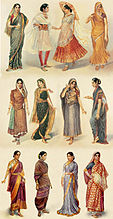

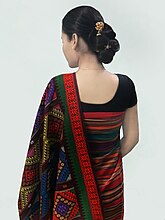

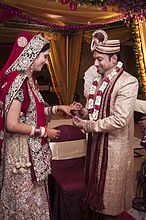







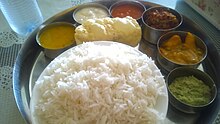
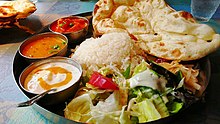




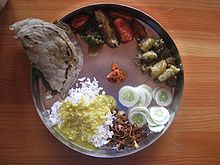







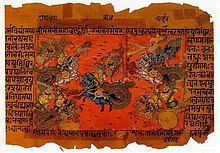


![Ilango Adigal is the author of Silappatikaram, one of the five great epics of Tamil literature.[2]](http://upload.wikimedia.org/wikipedia/commons/thumb/2/23/Puhar-ILango.jpg/146px-Puhar-ILango.jpg)

![Sanchi Stupa No.2, the earliest known stupa with important displays of decorative reliefs, circa 125 BCE.[3]](http://upload.wikimedia.org/wikipedia/commons/thumb/4/46/Sanchi_Stupa_No.2_Front_view1.jpg/220px-Sanchi_Stupa_No.2_Front_view1.jpg)




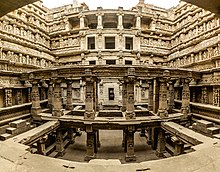
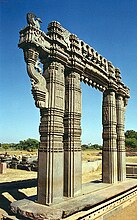

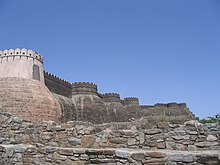

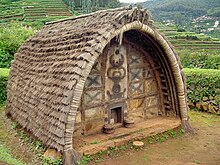





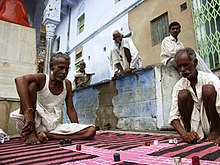
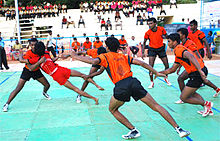
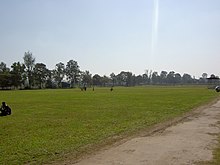
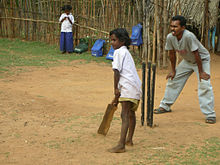
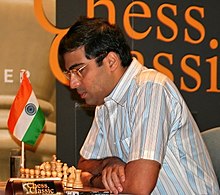
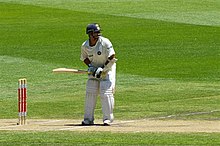




![A1 A farmer in Rajasthan milks his cow. Milk is India's largest crop by economic value. Worldwide, as of 2011[update], India had the largest herds of buffalo and cattle, and was the largest producer of milk.](http://upload.wikimedia.org/wikipedia/commons/thumb/b/ba/ILRI%2C_Stevie_Mann_-_Villager_and_calf_share_milk_from_cow_in_Rajasthan%2C_India.jpg/160px-ILRI%2C_Stevie_Mann_-_Villager_and_calf_share_milk_from_cow_in_Rajasthan%2C_India.jpg)




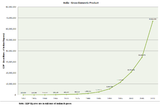






![B4 India has the world's second-largest mobile phone user base of 996.66 million users as of September 2015[update]. Shown here is a rooftop mobile phone tower in Bangalore](http://upload.wikimedia.org/wikipedia/commons/thumb/4/4f/Bangalore_cellphone_tower_November_2011_-30.jpg/113px-Bangalore_cellphone_tower_November_2011_-30.jpg)

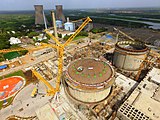




![N5 Propose as replacement for B5. India's organised retail sector deserves to represented because it is growing by 20-25% annually and will reach 18-20% of the total sector by 2020. [1]](http://upload.wikimedia.org/wikipedia/commons/thumb/6/62/Mango_atrium_at_Ambience_Mall%2C_Gurgaon.jpg/160px-Mango_atrium_at_Ambience_Mall%2C_Gurgaon.jpg)

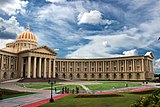



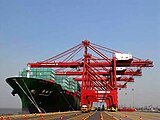
![Indian hockey team, captained by Dhyan Chand (standing second from left), after winning the finals at the 1936 Summer Olympics – their third of six consecutive Olympic golds.[citation needed]](http://upload.wikimedia.org/wikipedia/commons/thumb/8/8e/Indian-Hockey-Team-Berlin-1936.jpg/120px-Indian-Hockey-Team-Berlin-1936.jpg)
![Boys playing football in Manipur.[relevant?]](http://upload.wikimedia.org/wikipedia/commons/thumb/5/59/Soccer_football_informal_in_Manipur_India_cropped.jpg/120px-Soccer_football_informal_in_Manipur_India_cropped.jpg)
![Rukmini Devi Arundale, one of the foremost revivalists of bharatnatyam dance in the 20th century, performs at a concert.[citation needed]](http://upload.wikimedia.org/wikipedia/commons/thumb/1/1c/Rukmini_Devi.jpg/88px-Rukmini_Devi.jpg)
![Folk musicians in Hyderabad.[relevant?]](http://upload.wikimedia.org/wikipedia/commons/thumb/3/36/Indian_village_musicians.jpg/120px-Indian_village_musicians.jpg)

![Agricultural workers involved in Rice planting. Rice production in India reached 102.75 million tons in 2011–12.[citation needed]](http://upload.wikimedia.org/wikipedia/commons/thumb/3/34/Naathu_Naduthal.jpg/120px-Naathu_Naduthal.jpg)